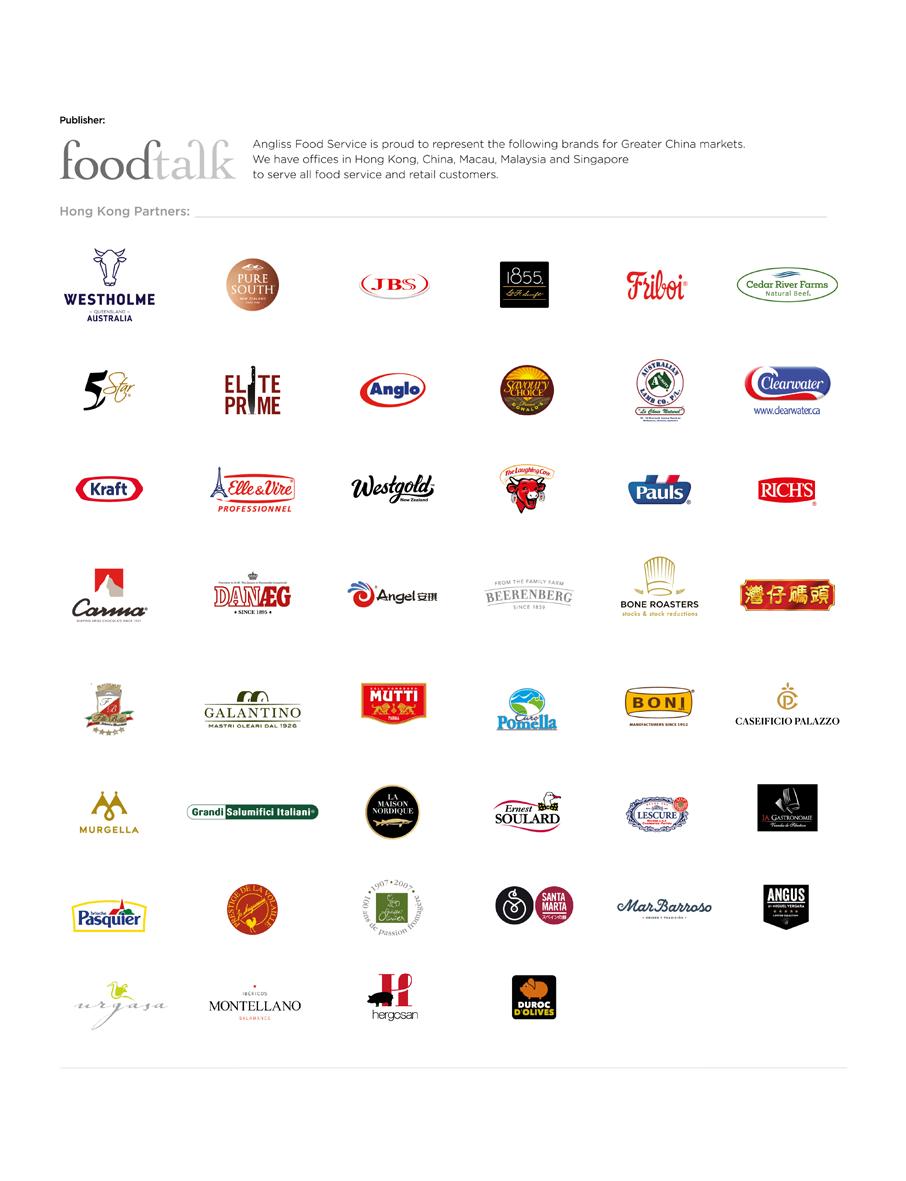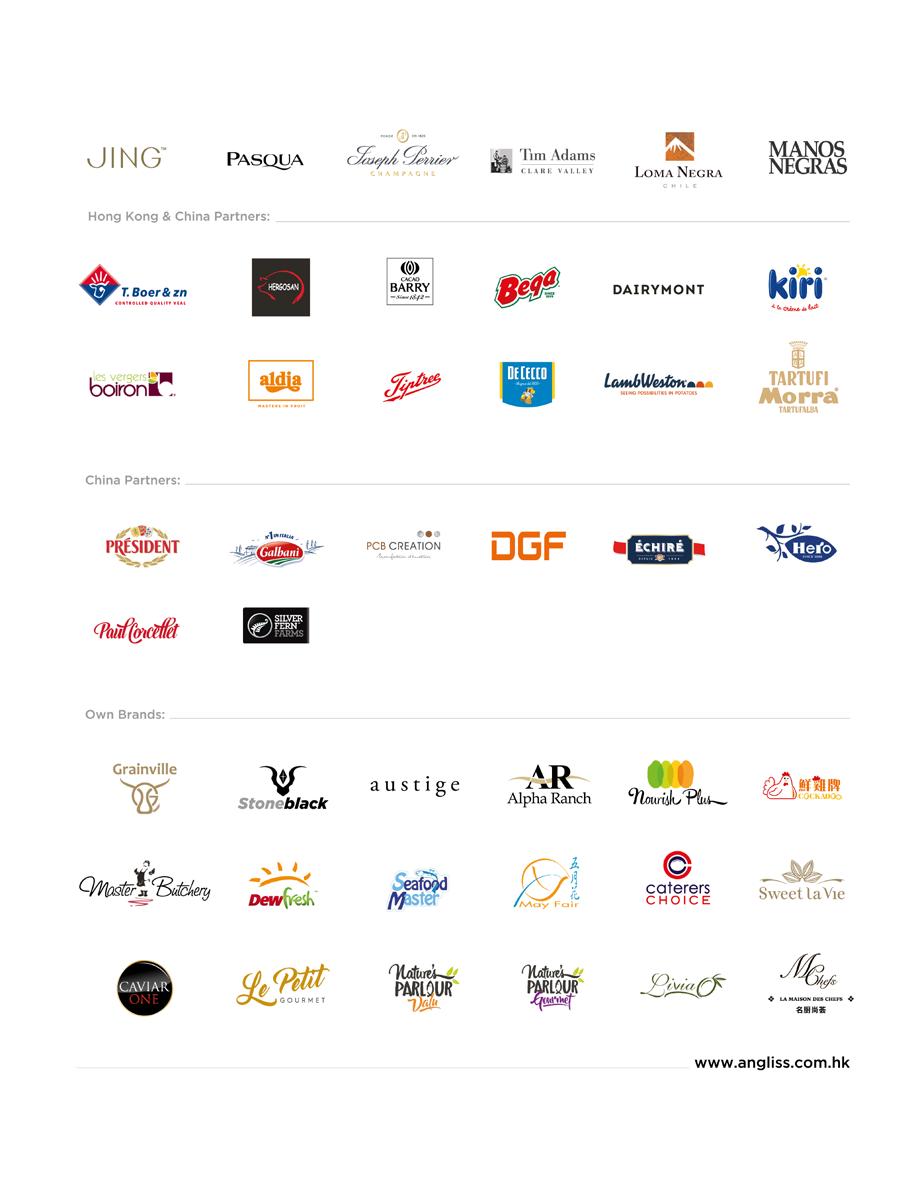




The festive season is a great opportunity to look back over the year and take stock of where we are at this moment in time. We are certainly in a far better place than we were at this point last year! At that time we were slowly emerging from a period of huge uncertainty and taking our first tentative steps in the post-Covid world.
While the pandemic is very much still with us, life continues to return to normal. As I have mentioned previously, Angliss HK played a small but significant part in this process, for which we can all be very proud.
But resting on our laurels is not the Angliss way. Ever taking the long-term view, we seek growth and expansion. To this end we have recently upgraded our warehouse in Tsing Yi with an additional floor. This gives us greater management and efficiency, optimises inbound and outbound logistics, and improves general operations in numerous other ways.
This increased capacity also readies us for peak season festivals like Christmas, the new year and Chinese New Year, when demand for our products and services climbs exponentially. It also puts us in a strong position to respond quickly to unpredictable but generally upward movement in the F&B economy, and a market still working to return to normalcy.
Angliss will continue to work closely with all stakeholders, clients, suppliers and other industry colleagues, and maintain good relationships with them. We also need to again acknowledge the contribution the company enjoys with its loyal workforce. Thank you, everyone, for your selfless commitment.
In this issue, you will find the usual mix of interviews and news featuring the most dynamic, innovative and outstanding professionals working in the industry today.
Enjoy the issue, and best wishes for the festive season!
Johnny Kang CEO - AsiaLeading Grand Lisboa Palace’s Palace Garden, the perfectionist chef looks to authentically recreate the best of the past while offering a culinary vision for the future

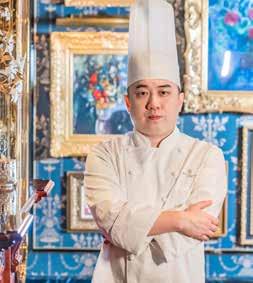

The Lavelle Library executive chef learned her trade in the demanding kitchens of Paris before returning home where she creates culinary art that evokes curiosity, joy and love

Chefs and guests were impressed by the cheese and wine pairings from Gourmet Partner Vietnam at recent ‘Beillevaire Cheese Journey’
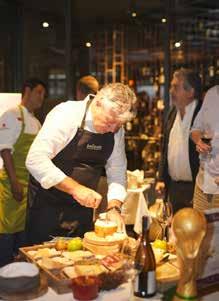
We all love cooking shows – but what is the reason for the longevity and success of this proven TV format?

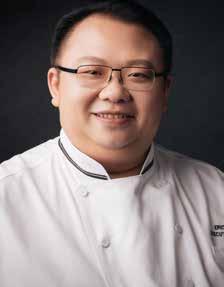
Describing himself as a “school dropout”, the inspirational Capella chef has spent his career leading teams, representing the industry and inspiring the next generation of chefs
Buttery, flaky and delicious, the kouign amann is the new old-fashioned pastry you never knew you needed
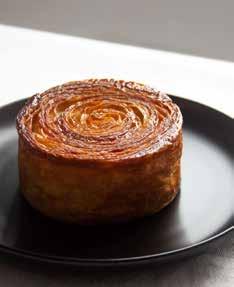
Incorporating elements of yin and yang gives the ANISE chef a spiritual reference point in his instinctive blending of eastern and western culinary techniques and flavours
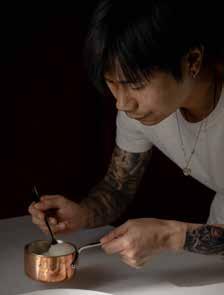
Angliss Guangzhou hosts ‘The High Jewellery of Butter’; Angliss Shenzhen throws ‘Beef Tasting Party’

Events, shows and F&B openings in Greater China and around the world

also has high
FT (Foodtalk): You were born in Auckland, New Zealand. Other than having access to high-quality produce from a pristine environment, we don’t hear much about NZ’s culinary culture. Can you describe the industry there?
GS (Glenn Saussey): People ask me this all the time and I am never sure how to answer! There is definitely a passionate food culture in New Zealand and always has
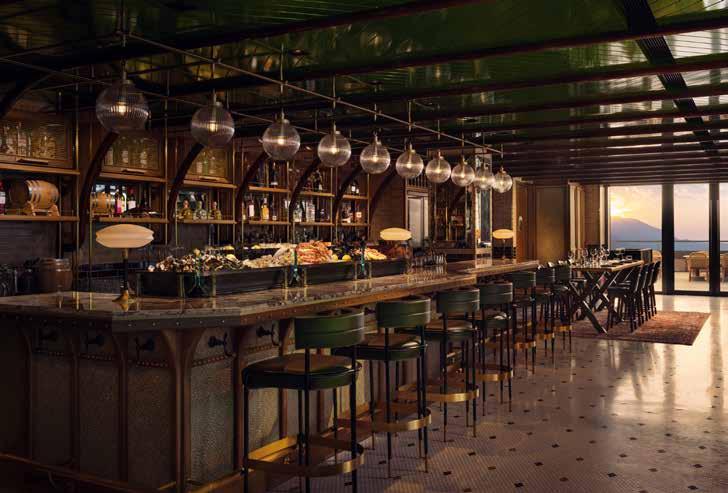
been. Many Asian and European countries have a much longer culinary history than New Zealand, which as a young place has not had the centuries to build its cuisine. However, it is a beautiful place with high quality produce of which we are very proud. To me, NZ’s culinary culture is rather showcasing what goes on the plate than the dishes themselves. Fresh, simple food and plenty of it is how I would sum it up! I see a lot of young NZ chefs doing good things and gaining great support from the hospitality industry, especially from our more experienced chefs. I am confident that this next generation of chefs will continue developing and creating with New Zealand products and produce, coming up with innovative and unique food and flavours.
FT: After 25 years as a chef, was it strange to exchange the whites for a suit, or did it feel like a natural progression? Do you miss the kitchen?
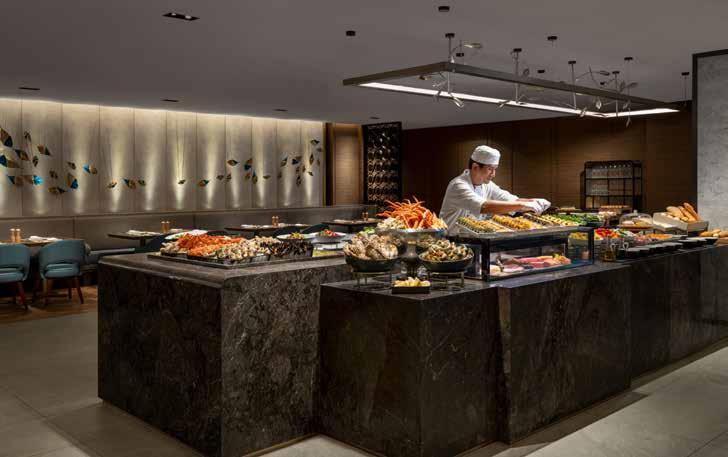
GS: I guess it was normal progression. I really enjoyed being a chef and the kitchen environment but was
得多,但新西蘭作為一個年輕的國家,飲食發展遠不及其他國 家般源遠流長,卻擁有無數的優質產品,作為新西蘭人我們對 此感到非常自豪。對我來說,新西蘭的飲食文化更著重如何展 示盤子上的食材,而非製作菜餚本身,總結而言,新西蘭的飲 食文化就是擁有大量新鮮,但簡單的食物。然而,我看到很多 年輕的新西蘭廚師技術精湛,並獲得不少酒店的青睞,當中尤 其得到富有經驗的廚師前輩的幫助。我相信,新一代的廚師將 會繼續創新和製作更多代表新西蘭的食品,為我們創作更多出 色又獨特的菜式和味道。 FT: 當了25年廚師後,你覺得從廚師轉換成管理層會不習 慣嗎,還是你會欣然接受?你會想念在廚房裡工作的日子嗎? GS: 我覺得這個轉變正常不過。我真的很享受當廚師,然而在 廚房裡工作,令我不斷思考一個問題 :「那下一步要怎樣?」。 當我做好了某件事情後,就會想要學習別的技巧,總是想要嘗 試不同的職位,學習更多技能,迎接更多挑戰。我會想念在廚 房裡工作的日子嗎?我是真的不想再下廚嗎 (雖然我經常在家 下廚);整天站在熱烘烘的焗爐前,按時為客人準備菜式。 然而,我仍然發現自己會像個廚師般在廚房裡徘徊,沒有半點 不自在。
I would become good at something, then want to learn something else! I always wanted more – more responsibility, more skills, more challengesCafe Lantau
increasingly asking myself “what next?” I would become good at something, then want to learn something else! I always wanted more – more responsibility, more skills, more challenges. Do I miss it? Not the cooking (I do cook at home often though); standing over a hot oven all day, trying to get things ready in time for service. I still find myself wandering around the kitchen, however, acting like a chef, and definitely feel comfortable in a kitchen.
FT: You worked for over five years as executive chef for Swissotel Beijing and Hilton Worldwide in Shanghai, from 2010. China was going through rapid development at that time, including the F&B industry. How would you sum up that experience?
GS: I had an amazing experience in China. I never planned to live there, and even travelling in the country never crossed my mind. However, in 2007, an Australian chef asked me to go with him on a food promotion tour around China for a month. Although unpaid he told me it would be a great journey and good for my career, so I thought why not? After three days I felt in love with the place and vowed to return to work full time. In 2010 my wish came true and I was transferred to Beijing. Travelling somewhere and working there are very different though, and it took me nearly a year to settle down, learn the culture, food and language. Moving from little New Zealand to China was not like travelling to another country, it was like going to another planet! I really enjoyed working with my team of keen and passionate chefs, who were friendly, warm and always

took care of me. The person who came out five years later was better, stronger and more educated, and for that I am thankful.
FT: High points in your career so far have included working on a billionaire’s super yacht in Thailand, outside catering at The Great Wall and Summer Palace in Beijing, and leading culinary teams at major sporting events. Are there any specific memories that stand out?
GS: There are many memorable moments, at least one for every kitchen where I have worked! The Shanghai Tennis Masters, between 2012-2015, definitely comes to mind first. Hilton Shanghai had been catering for the event for three or four years before I arrived, but the organisers wanted to introduce new concepts and fresh ideas. We had to build kitchens from nothing, from where we developed 120 different menus, with players, VIPs and the public requiring breakfast, lunch and dinner. I worked over 100 hours a week with amazing senior chefs, most of whom did not speak English, to pull it off successfully every year, something I am very
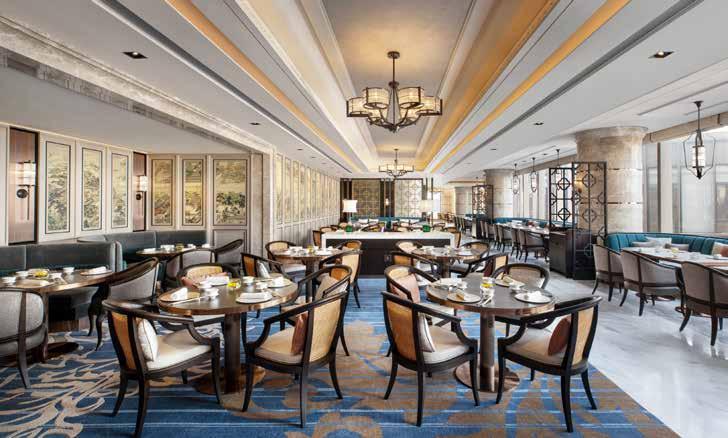
I need to lead the team and stay focused on our restaurant concepts and F&B strategy, making sure we are relevant, fresh and intriguing
proud of. I never imagined that a boy from New Zealand would have that experience. Actually, the whole 25-year hospitality journey has been memorable, and I am so lucky. I have worked in eight counties, more than 40 kitchens and restaurants and met so many different people and cultures. I have a passion for my work, which makes it easy and satisfying. There is a saying: ‘if you love what you do, you will never work a day in your life”. I have that.
FT: Can you explain your different responsibilities for the two properties you oversee? What was it like to be part of the opening team for Marriott’s first dual-brand hotel in Hong Kong?
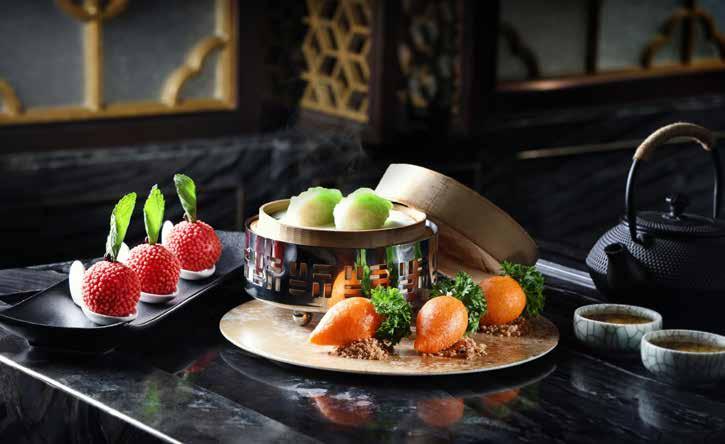
GS: I am very thankful to have been given the opportunity by Marriott to be involved in its first dualbrand hotel in Hong Kong. We have an energetic team here led by our talented cluster general manager, Sander Looijen, who has also been very supportive. We had a lot of fun and challenges, but looking back at what we as a team created is a great feeling. As director of F&B for both properties, my responsibilities are to ensure we are constantly performing to a high standard, with a clear direction. We have four outlets and a large banqueting ballroom at the Sheraton, and the 271-seat Tung Chung Kitchen and the Harbour Lounge at Four Points by Sheraton. I need to lead the team and stay focused on our concepts and strategy, making sure we are relevant, fresh and intriguing.

FT: What’s the concept at the dining experience for Four Points by Sheraton, described as “a community dining hub”? Do you always look to innovate?
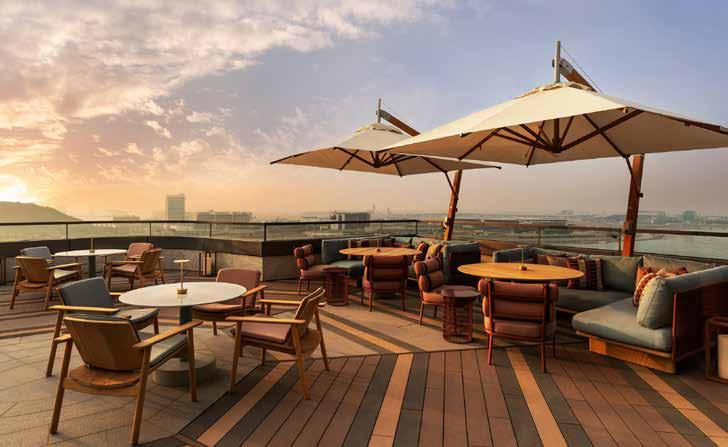
GS: Being innovative and creative is a necessary part of F&B, if you want to progress, and we knew Four Points by Sheraton had to be different. Designed to be uncomplicated and fun, the concept focuses on buffets, with salad, western carving, Asian specialty highlights etc. We also created a kids’ zone with entertainment at Tung Chung Kitchen. Although the concept has been successful, because of market demand it will convert to a more casual, full buffet after Chinese New Year. So the community can bring the whole family to relax, while enjoying lunch or dinner.
FT: What is it about the Sheraton brand that appeals to you?
GS: It is all about bringing people together into our community by providing them with warm, friendly and welcoming services. I love working with people and
FT: 你曾經說過,你覺得很幸運能與強大的團隊一起工作, 那你是如何建立你的團隊,又會如何描述你的管理風格呢? GS: 我盡力保持公平,誠實對待每個人。我希望我的團隊能夠 享受他們的工作,從中學習和成長。我情願員工們每天工作 10-12小時,每週工作5天,但能發揮他們的最高工作能力, 而非失去熱情地長時間工作。我希望他們早上醒來會期待來 上班,知道他們能在這裡學到一些東西,迎接無限可能,但我 也希望他們能回家,擁有工作以外的個人生活。團隊合作是酒 店發展良好的重中之重,我著重讓我的伙伴發揮最大潛能。
如果你渴望學習,勇於挑戰自己,願意幫助作出決策,我們就 十分適合一起工作了。每個人都是獨一無二的,管理方法便需 要針對此而作出調整,絕不能一成不變!了解團隊裡每個人的 個性後,你就可以更容易幫助他們發揮所長,達到最佳表現。
We should enjoy life, whatever we do. I always try to give my best, learn from the experience and be proud of what I have achievedSunset Grill Terrace
sharing ideas and experiences with team members, colleagues and guests. We are a team, almost like a family, working to the same goals, and I really enjoy this philosophy. Sheraton is also one of the most popular and trusted brands in the world.
FT: You have said you have always been lucky to work with strong teams. How do you build them, and how would you describe your management style?
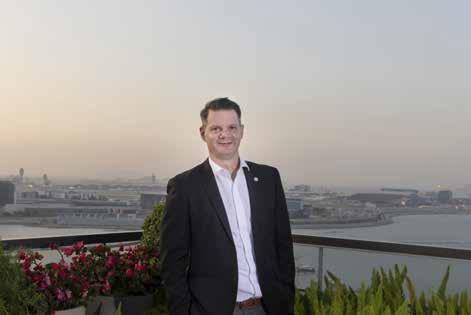
GS: I try to be fair and honest. I want my team to enjoy their jobs, to learn and grow. I would rather staff work to their best ability for 10-12 hours a day, five days a week, than longer hours but less enthusiastically. I want them to wake up in the morning and look forward to coming to work knowing they are going to learn something and anything could happen. But I also want them to go home and have a life outside work. In order to do a good job, teamwork is the top priority, and I focus to get the best out of the people who work with me. If you want to learn, challenge yourself and be empowered to make decisions then our styles will match. Everyone is different, so this needs to be reflected in the management approach. You can’t charge in like a bull in a china shop! Once you know your team members’ personalities you can use that to get their best performances.
FT: You have commented “Here for a good time not a long time, so we must enjoy and be proud of what we do,” and “All you can control in life is how you respond to life.” Can you explain this philosophy?
GS: I like quotations and the way they relate to our daily lives; they can simplify things and make you think. The first one simply means that we should enjoy life, whatever we do. I always try to give my best, learn from the experience and be proud of what I have achieved. The second I saw in a movie, and means that we have no control over anything except how we respond to situations. It is a mindset. However, controlling our very active wandering minds is easier said than done!
FT: What ambitions still remain for you?
GS: I want to keep going – I love challenges, and doing new things is exciting. I have been fortunate in my career to have many opportunities, and believe that with Marriott, many still lie ahead. If you work hard, good things will come. But my wife and daughter, happiness and health are the most important things in my life.
FT: 你曾說過:「在這裡工作的時光美好 卻非永恆,因此我們必須享受一切,並為 自己的成就感到自豪。」,也說過「生活 中唯一能控制的事,就是你如何去面對 生活。」你為什麼會這樣說呢?
GS: 我對諺語十分著迷,因為它們跟我們 的日常生活息息相關,可以簡化瑣事, 發人深省。第一句話的意思很簡單,就是 指我們應該享受生活中發生的每一件事。 我總是努力做到最好,從經驗中汲取 教訓,並為自己的成就感到自豪。第二句 則是我在一部電影中看到的,它是指我們 無法掌控任何事情的發展,除了自己面對 事情時的心態。然而,要妥善管理我們變 幻莫測的思維,說來容易做起來卻很難。
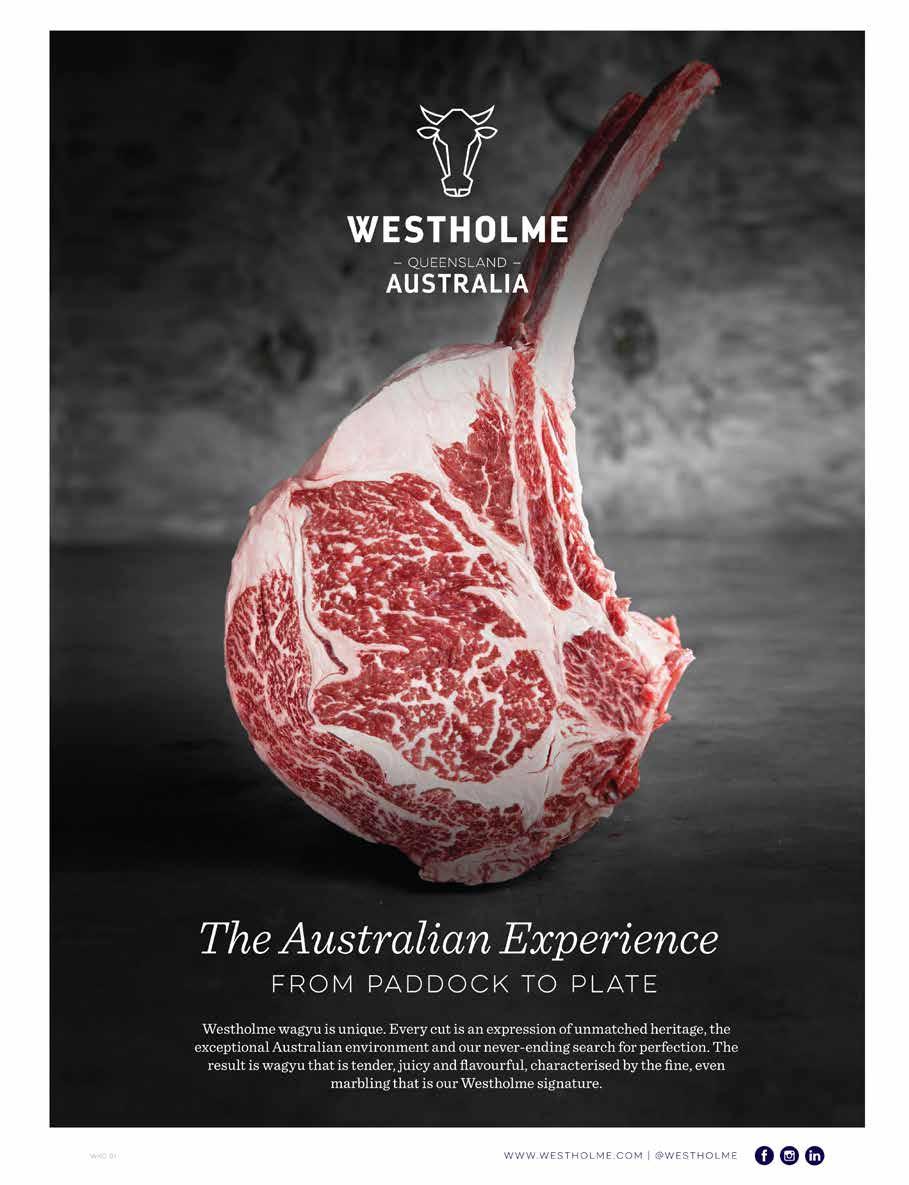
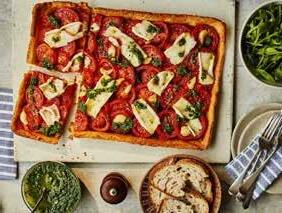
Hosting a festive gathering this winter period and don’t know where to start with the menu? With British chef Mary Berry’s new cookbook, you’ll have all the perfect recipes at your doorstep
During this festive season, wherever you are on the globe, you can always cosy up with the hearty, warming and stunningly delicious recipes you crave at this time of year.
Popular chef Mary Berry, alongside her new cooking show on the BBC (sharing the same name as the book) premiered in early September, has released a cookbook, Cook and Share. The beloved cookbook author and former judge on popular “Great British Bake-Off” TV show shares 120 of her favourite recipes to keep us warm and happy this winter period.
From soups to roasts to salads, from meals for big groups or picky teenagers, to her most delicious bakes for a wonderful end to the night, Cook and Share by the 85-year-old is the perfect recipe book you’ll need this festive season.
With delicious yet straightforward savouries such as eggy bread avocado and ham sandwich, Tuscan chicken and Sunday best minted lamb, delectable desserts include shortbread drizzled with white chocolate, salted caramel brownies, Sunday lunch plum crumble cake and more.
Berry’s writing is approachable and easy to follow, with the book a great resource for both experienced and novice cooks. The focus on bringing people together around the dinner table makes this a particularly timely and relevant read. In addition to the recipes featured in her new BBC series, the book includes many more from Berry’s kitchen.
With her decades of experience and expertise, readers can trust that they will be able to create delicious meals that will be enjoyed by all. Whether you're looking for ideas for a special occasion or just a weeknight dinner, Mary Berry's Cook and Share has something for everyone.

今年佳節期間,無論您身在世界哪個角落,都可以享受到一系 列讓人期待已久、豐盛窩心的美味食譜。 名廚 Mary Berry 在 BBC 主持的全新烹飪節目於今年 9 月初 首播,最近她亦推出了與節目同名的全新食譜《Cook and Share》。這位深受大眾愛戴的食譜作家,聯同英國著名電視 節目《大英烤焗大賽》的前評審一起分享了她最喜歡的 120 款 食譜,讓我們度過一個既溫馨又愉快的冬天。
不論是濃湯、烤肉還是沙律,又或在大型聚餐和追求美食的年
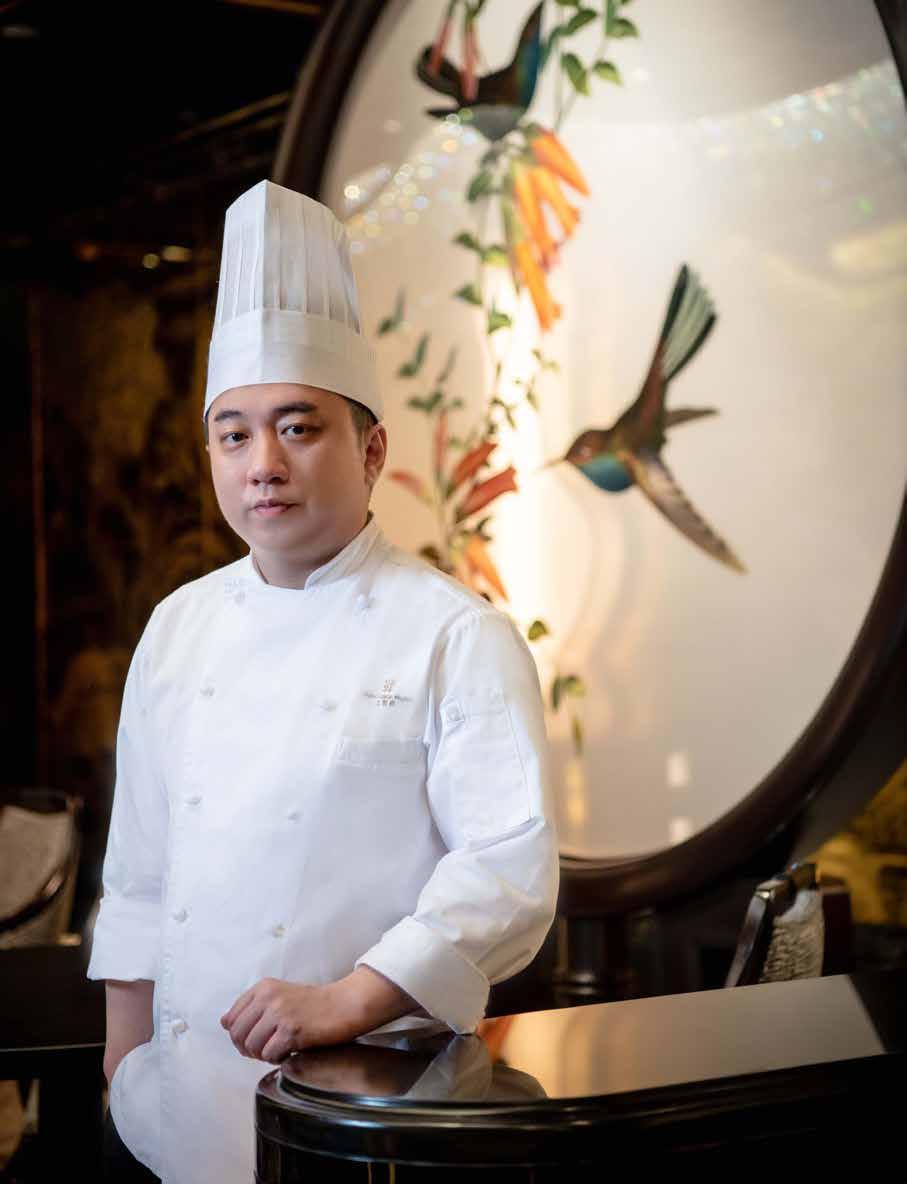
Ken Chong, Head Chef at Grand Lisboa Palace Resort Macau’s Palace Garden in Macau, is a true perfectionist, crafting authentic dishes that pay homage to a glorious culinary past while challenging diners with innovative and exciting new tastes
FT(Foodtalk): You graduated from the renowned Hong Kong Culinary Academy. Other than the technical skills, what were your main takeaways from this experience? KC(Ken Chong): I learned a lot of things other than just cooking. The three-month internship at the Academy’s Clubhouse was particularly useful, as I got to learn the complete workflow of serving a dish from kitchen to table. It highlighted many things I needed to pay more attention to, and gave me further insight into the needs of
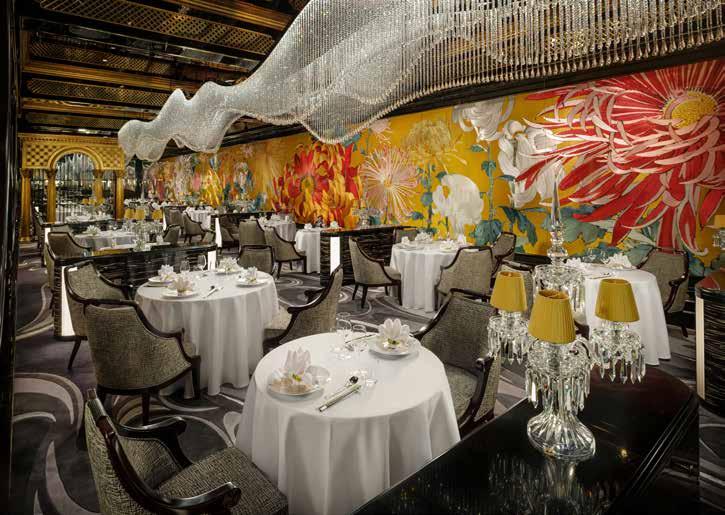
the guests. This experience paved the path for my culinary career, allowing me to take my colleagues’ activity in the dining area and the needs of guests into consideration while I’m cooking in the kitchen.
FT: You were able to train with your mentor, Master Chef Yau Tim Lai, as he worked around the world as a guest chef for celebrities. What was so special about this stint?
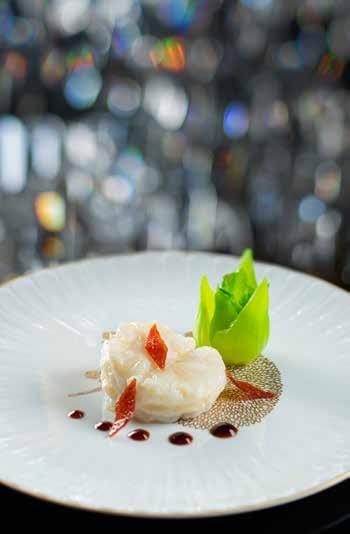
KC: When I was in Hong Kong, I followed Master Lai to different celebrities’ homes as a guest chef at least twice a week. At the beginning Master Lai guided me through the process of ingredient preparation; after around a year he let me take care of the entire process: from ordering and checking ingredients, cutting and seasoning, to the preparation of broths and dried seafood. As these tasks required a comprehensive skill set, I found myself improving step-by-step during the preparation process. After I had honed these skills, Master Lai let me work alongside him as a guest chef around the world, visiting Las Vegas, South Korea, Indonesia and Singapore to cook for various celebrities and at special events. The most valuable thing was learning how to adapt and find suitable ingredients from all those places, cooking excellent Taishi cuisine just like we would in Hong Kong for guests around the globe. Those were really great experiences to me, and they really levelled up my knowledge and skillset, making me who I am today.
FT: At just 26, you moved to Shanghai to develop and open four branches of the Chinese restaurant you were working for at that time, making high-level decisions on every part of the process. What did you learn from this experience?
KC: During my 10 years in Shanghai, I opened restaurants for the company I worked for, from small establishments to huge fine dining restaurants. I learned how to plan carefully for every occasion, ensuring every step of the process was smooth so mistakes could be avoided. I also learned that one should treat every detail seriously, no matter how small. The experience of opening the Shenzhen restaurant was a really memorable one, as I had to handle everything myself, from budgets and opening preparations to staff recruitment. This really gave me a deep understanding of how a restaurant operates.
I consider myself quite a daring person. Aside from making authentic and refined Cantonese cuisine, when I research new dishes I like to experiment using traditional techniques with overseas ingredients
FT: You are an adherent of authentic Taishi cuisine, which is developed from legendary ‘royal’ Cantonese cuisine now hard to find. Can you explain more? And are dishes such as ‘chicken testes pudding’ difficult for diners to accept?

KC: Guangdong’s Nanhai district is the birthplace of two great gourmand families – Taishi and Tanjia. Although both cuisines were served at banquets at the imperial court, unlike Tanjia cuisine, which found its fame in the capital, Taishi cuisine has remained firmly within Guangdong. Passed down through the generations, its refinement and renown grew, culminating in its receiving titles as a ‘UNESCO Masterpiece of the Oral and Intangible Heritage of Humanity’ and ‘China’s First Cantonese Cuisine’. The eponymous Taishi snake soup (premium partridge bisque on Palace Garden’s menu), one of the most recognisable dishes from the cuisine, is an example of the knife finesse and delicate preparation characteristic of Taishi cuisine. Taishi cuisine is also unique in its use of unconventional ingredients, such as the ‘chicken testes pudding’. Of course, not everyone is able to stomach the idea of eating chicken testes! But similarly, there are lots of people who are excited and enthusiastic about trying out the more unusual dishes within China’s vast and profound culinary culture. For these guests, we do our best to give them an authentic Taishi experience, with the hope that they are able to appreciate its intricacies.
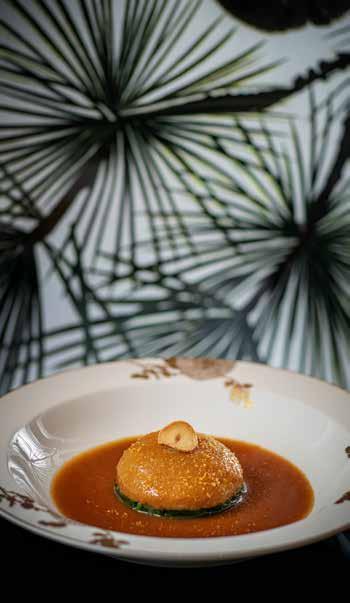
All food, at its core, is about flavour. No matter how many variations a dish has, or how it looks, most important is how it tastes
FT: As well as Taishi dishes, Palace Garden offers traditional and other unusual Cantonese dishes from the Qing Dynasty. Can you provide some examples of this, and cuisine you have personally developed?
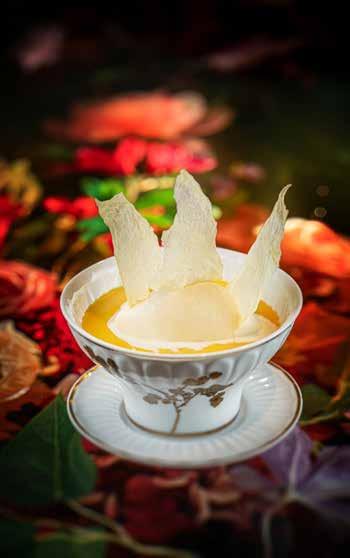
KC: Palace Garden has a signature dish which brings together Cantonese traditions and deft culinary technique. This dish, ‘Crystal king tiger prawns’, uses Vietnamese king prawns with their red skin carefully removed. The prawn meat is then marinated with spices and cooked Cantonese-style, giving the meat its al dente bite, refreshing taste, and transparent appearance.
To complete the dish, we serve it with 52-month aged Iberico ham and a homemade 25-year aged balsamic vinaigrette dressing with oyster essence, further developing the flavour in new ways. One of our bolder dishes at Palace Garden is ‘Star-spotted garoupa steamed with homemade spring onion and Sichuan pepper sauce’. To increase the complexity of flavour I created my own spring onion and Sichuan pepper sauce, enhancing the delicate layers of the fish meat. The fragrance and sharpness of the spring onion and Sichuan pepper brings diners a shock to the tastebuds upon first bite!
FT: You have said that Grand Lisboa Palace has given you carte blanche to create your own team and the restaurant menu. Can you provide any examples of where you made more unconventional decisions?
KC: I consider myself quite a daring person. Aside from making authentic and refined Cantonese cuisine, when I research new dishes I like to experiment using traditional techniques with overseas ingredients. This has led to all sorts of speciality Cantonese dishes, such as ‘Yunnan morel mushroom double boiled with bean curd in a chrysanthemum shape’. Taking reference from the Huaiyang-style knife skills used to create Wensi tofu soup, we craft the tofu into a delicate chrysanthemum shape. Next, we create the soup base using traditional Cantonese methods, adding the unconventional ingredient of Japanese konbu kelp for freshness. In just one dish, we have integrated the skills and cultures of three regions.
FT: You also seek to interpret Grand Lisboa Palace’s Eastmeets-West philosophy concept in your cuisine. Can you give any examples of how you have achieved this?
KC: At Palace Garden, we have a dish, ‘Foie gras and chicken wrapped in crispy waffle paper’. While chicken
我創新搭配風乾了52個月的西班牙伊比利亞火腿,伴碟的 自製蠔汁融入了25年陳釀意大利黑醋,增加風味。我在御花 園烹調出的其中一道創新菜式便是香蔥椒麻醬蒸東星斑。粵菜 講求鮮,一般的傳統做法是用蒸魚豉油清蒸。為了增添不同的 口味,我特別研發出香蔥椒麻醬,增加了魚肉的層次,入口時 既吃到蔥香和椒麻的味道,從而刺激到食客的味蕾,呈獻與別 不同的體驗。
wrapped in paper is a nostalgic Hong Kong dish served in many traditional Cantonese restaurants, we have put a contemporary spin on the original, replacing the chicken liver with foie gras, an ingredient commonly used in Western cuisine. This not only makes the taste and texture richer, it demonstrates how the meeting of Chinese and Western sensibilities can create new flavours. We also infuse elements of East-meets-West aesthetics in the plating.
FT: You have a reputation as a perfectionist. Why are the smallest details important to you?
KC: All food, at its core, is about flavour. No matter how many variations a dish has, or how it looks, most important is how it tastes. This is why I always make sure the flavours of every dish are carefully calibrated. Consistency is also crucial – even the plating of the accompaniments and side dishes must be the same.
FT: With your extensive experience of F&B operation and management, what are your top three guidelines on running a successful restaurant business?
KC: Talent, ingredients, and financial smarts. By talent I mean extracting the most potential from each individual. Matching the right kind of responsibilities to the right person helps the company achieve good management standards. At the same time, it allows for employees to
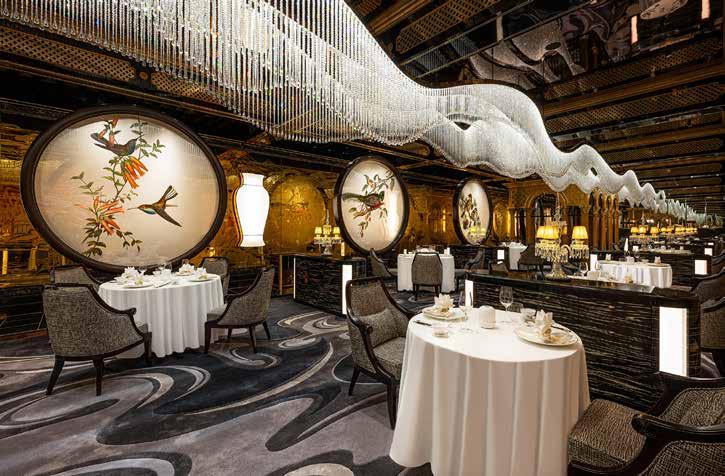
develop their professional strengths, which in turn is useful when creating new menus. Secondly, the ingredients are one of the most important aspects of a restaurant.
I believe in the 3:7 principle: a good dish relies 30% on culinary skill and 70% on the ingredients. With this in mind, the quality of the ingredients play a key role. Finally, financial smarts include the management of staffing, costs and expenditures.
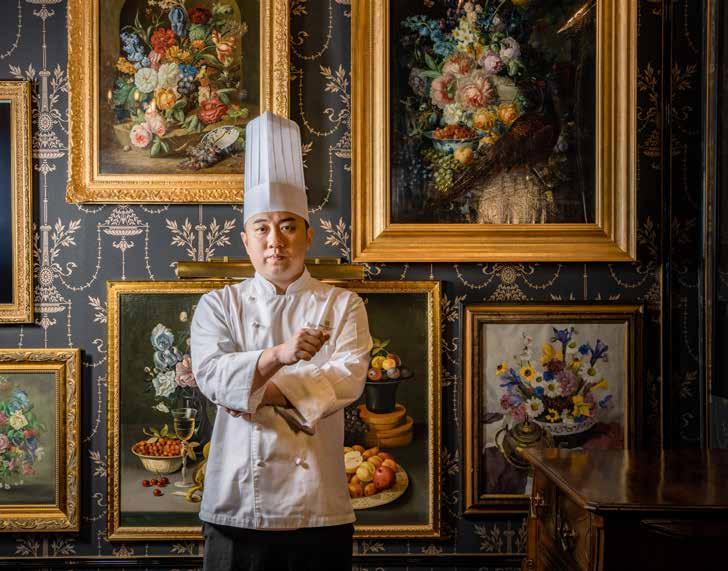
FT: Other than Chinese cuisine, what other food do you enjoy cooking and eating?
KC: I admire the simplicity and elegance of Japanese cuisine. Interestingly, I think Japanese cuisine in particular is quite exemplary of the 3:7 principle.
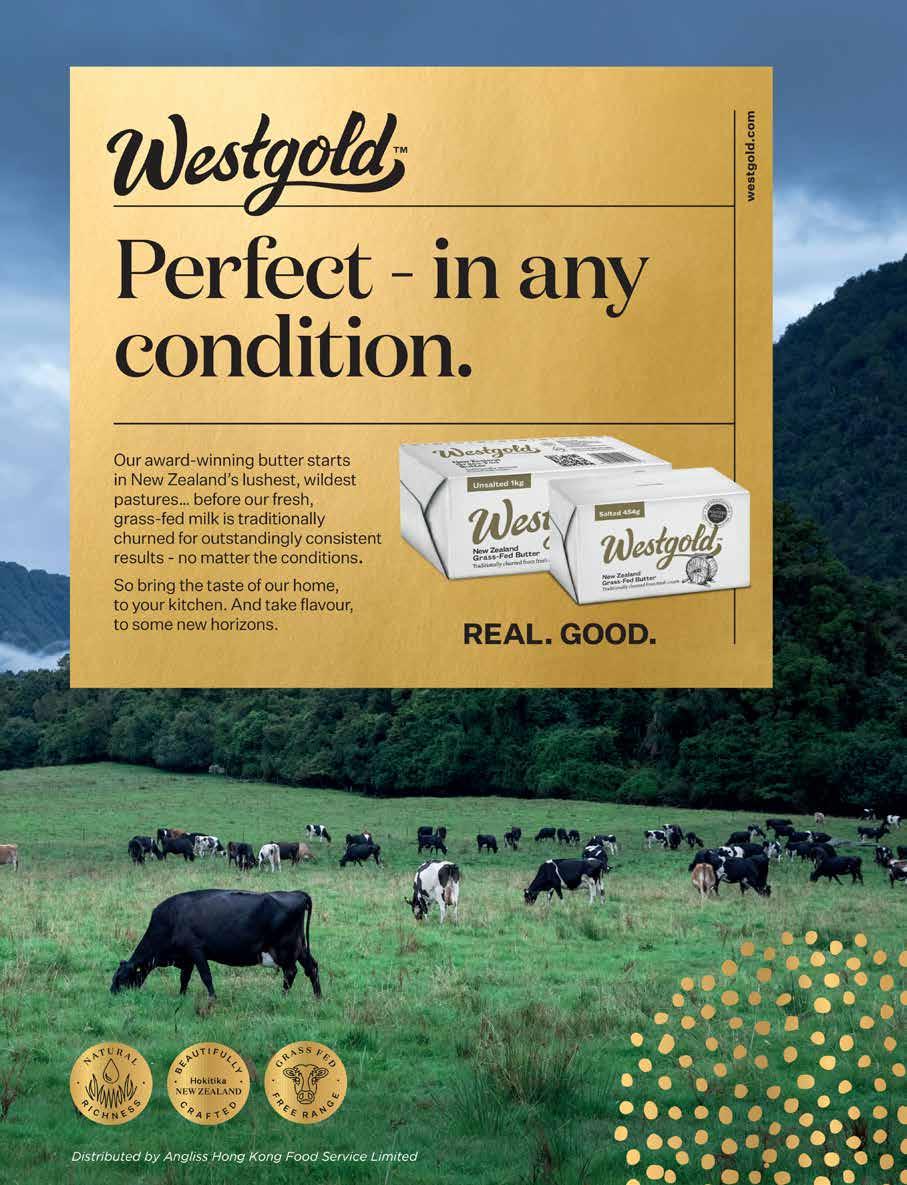
The Ardo Group began producing and supplying fresh-frozen vegetables in its native Belgium in the 1950s, and has since gone from strength to strength guided by a philosophy of quality, customer satisfaction, innovation and sustainability

Ina fast-moving food industry, where every second counts, wouldn’t it be convenient to have a partner who can provide the finest quality fresh-frozen vegetables, fruit and herbs, immediately available, 100% reliable and totally delicious?
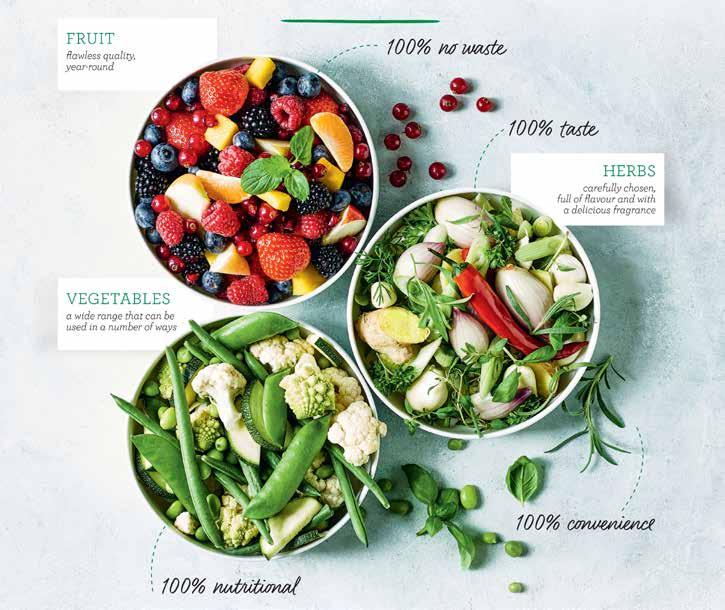
That’s where The Ardo Group comes in. The renowned Belgian family-owned company, which began its activities in the 1950s, produces and supplies fresh-frozen vegetables, rice, pasta, potatoes, herbs and fruits. These include avocado, risotto, broccoli, quinoa kale burger, baby carrots and much more.
Ardo’s products are completely natural, providing the perfect base for a wide range of dishes and uses. The company’s pledge is “100% no waste”, “100% taste”, “100% convenience” and “100% nutritional”.
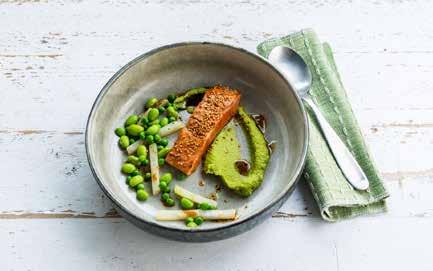

Already cleaned, washed and cut, they also offer a long shelf life of 18 to 30 months. All products are completely natural, grown, harvested and processed with full care and dedication, and frozen very quickly after harvesting, resulting in the maximum conversation of vitamins and nutritional values.
Quality is the cornerstone of Ardo’s strategy, alongside its determination to provide customers with products of the highest safety and quality standards, meeting internationally recognised standards including BRC/IFS and HACCP.
These efforts have certainly contributed toward Ardo’s success. Today, the company owns 20 production and packing units in nine European countries. With a €1.2 billion annual turnover, it supplies 947,000 tonnes of produce every year, exporting to more than 100 countries. Its 4,000 employees are supported by 3,500 growers, across 50,000 hectares.
Production, packing and distribution sites located in Europe’s most fertile growing regions, is also advantageous, ensuring that only minutes are lost between harvest and storage. Other key factors include the company’s extensive sales offices, located in Europe, the USA, China and its ‘glocal’ approach, meaning it can react more efficiently, anticipating customers' quicklydeveloping needs.
Ardo
18 至 30 個月的保 質期。所有產品都經過精心種植、收割及加工,保證絕對天然。由於食材在 收割後會迅速冷凍,因而能夠盡量保留當中的維他命和營養價值。
注重品質是 Ardo 在業務策略上的重要基石,它們不僅致力為客戶提供符合 最嚴格安全和品質水平的產品 ,更一直遵循包括 BRC/IFS 及 HACCP 等國 際認可標準。 全賴以上的堅持和努力,Ardo 才能締造出今天理想的成績。Ardo 目前 在歐洲 9 個國家擁有 20 個生產及包裝工場,每年營業額高達 12 億歐元, 其中供應 947,000 噸農產品,並出口至 100 多個國家。此外,集團亦擁有 4,000 名員工和 3,500 名菜農,種植面積達 50,000 公頃。

Thao Na, Executive Chef at Lavelle Library Ho Chi Minh City, is a seasoned professional, having earned her stripes in France’s top kitchens before returning to Vietnam to great acclaim. And while she remains humble, happy to clean the toilet or sear a scallop, for those planning to visit her renowned restaurant, please note – “entitled pretentious egos” are not welcome!
FT(Foodtalk): Did you know from an early age you wanted to work with food when you were older?
TN(Thao Na): I discovered my passion for food at eight, when I would play “Che Shop” with my friends and neighbours, pretending to cook with plastic cookware toys and imagined ingredients. But I had a strong curiosity to make real, edible chè [Vietnamese sweet beverages, soups and desserts], and made it a mission to learn how to properly use kitchen tools, an open fire and combine ingredients to make something delicious. My proudest creation was my version of taro chè. I still remember feeling such joy seeing everyone enjoy it and even ask for more! It was so fun. As much as I enjoyed playing chef, however, I did not think of it as a career choice until I turned 18.
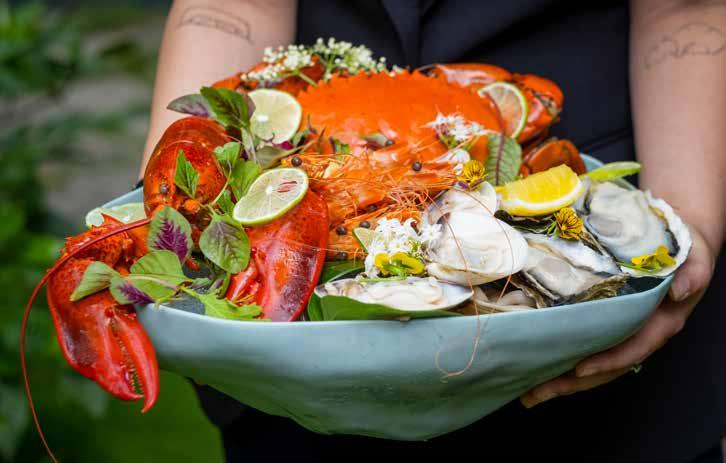
FT: You spent 11 years in Paris, where you qualified in French cuisine. We know that Vietnam and France have a relationship going back over a century, but what was your motivation in spending so long there?
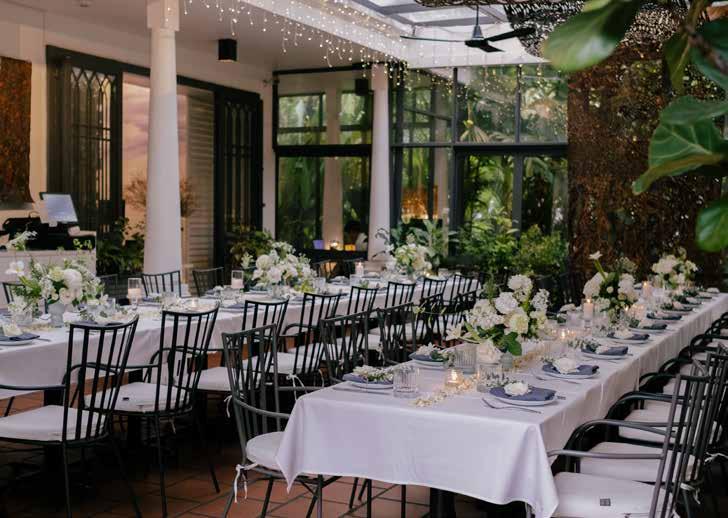
TN: I moved to Paris when I was only 21. I was eager to learn, work and pursue my passion in one of the culinary capitals of the world. It was an exciting new chapter in my life, where I met my mentor Chef Jean Francois Rouquette, and felt so blessed to be working directly with one of the most respected chefs in Paris. And when you are working with the best, the learning never ends. Although I have been back in Vietnam for eight years, Paris will always have a special place in my heart and my youth. There is a phrase “Paris est toujours une bonne idée,” which means “Paris is always a good idea.” For
chè
me, the City of Light will forever illuminate my soul and ignite my passions in both culinary ventures and life.
FT: Part of your Paris experience was with Hyatt, working for seven years with the group as sous chef before going on as chef/founder at Atelier Des Reves and a professor at Saigontourist Hospitality College. Can you describe those experiences and how they informed your career?
TN: I am forever humbled and thankful for my experience at Park Hyatt Paris Vendôme. I started as an intern, and over time, worked my way up to junior sous chef. One of the most important takeaways from this experience was the value of completing a task with integrity and care. Regardless of the level of work –washing dishes, deboning chicken, searing scallops – in the kitchen, you have to stay focused and truly care about everything you do. This is a value I live and work by, which has significantly impacted who I work with and choose to join my team.
FT: More than simply a restaurant, Lavelle Library is a lifestyle and social space that brings together people, art and nature. Why did this environment particularly appeal to you?

TN: My philosophy as a chef is to create dishes that delicately balance the natural taste of high quality
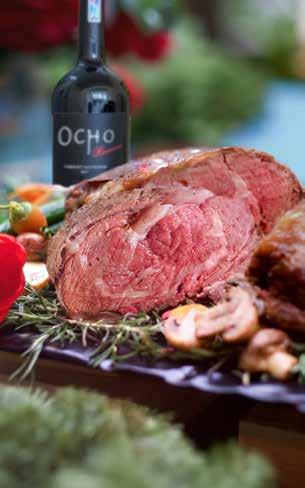
ingredients with refreshingly new flavours. It is my desire for guests to enjoy each dish with a special kind of happiness, as if they discovered something familiar and yet new at the same time. Lavelle Library’s ethos of bringing together people, art and nature aligns with my philosophy of living life harmoniously.
FT: Can you describe the extent of your responsibilities at the restaurant?
TN: Everything! Each teammate is a valued member of the Lavelle Family. Regardless of position, we are all equally responsible for the success of every dining and event experience. That means we share all roles. There isn’t anything I haven’t done – from menu creation to
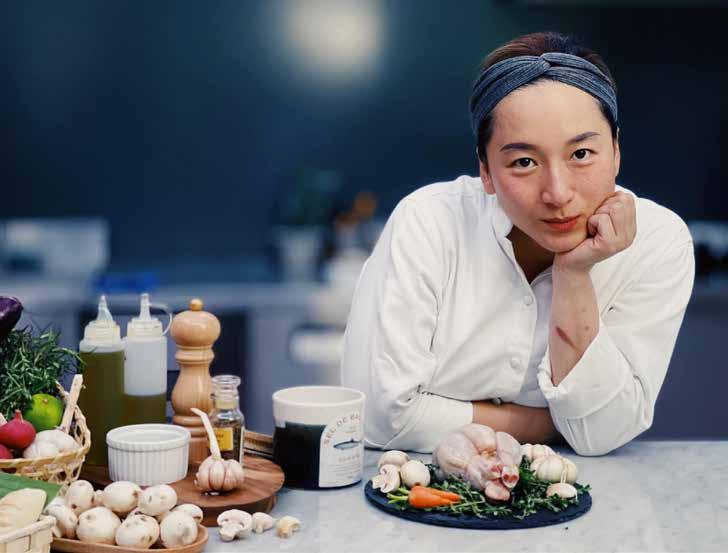
giftbox design, from toilet cleaning to dishwashing. I take part in it all, which is what being part of a family is all about.
FT: How do you avoid fusion clichés while allowing both your Vietnamese heritage and classic French culinary training to creatively co-exist?
TN: Vietnamese and French cuisine are unique in taste and method of preparation. The beauty of both is the ability to respect the natural flavours of high quality ingredients. A good quality cut of beef does not need much seasoning to maximise its potential. A grade A sweet potato only needs to be grilled. There is no necessity to have strong seasoning or heavy sauces overpower the main ingredients. I like to blend both cuisines by using traditional cooking techniques rooted in both cultures to create dishes that have a balance of tastes. For instance, sometimes a dish can be buttery with a hint of umami. In addition to flavour, I’m passionate about designing dishes with character. A dish as traditional as steak tartare can be playfully consumed as a taco. Food should not only look and taste delicious,

but evoke emotions in the way you interact with them as well – curiosity, joy, love, etc. That is why it’s called art.

FT: Lavelle Library features a popular Chef’s Table, where, according to its website, “our chef’s wildest ideas are embraced”. Can you give some examples? Also, the website warns that “entitled pretentious egos are not welcome” at the Chef’s Table. Why do you feel this warning is necessary?
TN: Lavelle Library’s Chef’s Table is an opportunity for myself and my guest chefs to experiment and try new ideas. We designed the experience as an intimate space where guests disconnect from the hustle and bustle of life and focus on the present – enjoy food with loved ones, taste those new ideas and interact directly with the chefs. Through the power of social media, many diners are immediately self-proclaimed food critics,
as if they discovered something familiar and yet new at the same time
whose comments can be uplifting or cruel. There is a lot of heart and sweat invested in creating something new, and we value guests who appreciate the process, rather than critics. There is enough judgement in the world. Instead, it is a space for kindness, discovery and acceptance.
FT: You collaborate with other chefs, such as a few months ago with renowned executive chef/owner Tsuruhara Shozo of Fume Restaurant and Sushi Rei also in Ho Chi Minh. What do you value about these partnerships?
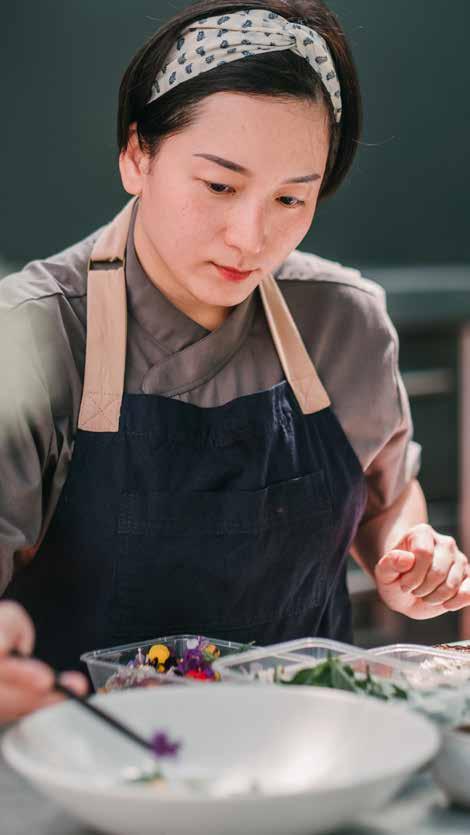
TN: The beauty of each collaboration is process of learning and exchanging ideas with talented chefs. I enjoy learning more about their passions and expertise, which inspires me to explore more flavours and even create dishes in their honour. I value the friendships I’ve developed with the talented Chef Tomo san and Chef Shozo san, and look forward to working with them again.
FT: There has been an exponential increase in the number of women in top chef roles over the past 10 years to 15 years. What have your personal experiences been in an industry traditionally dominated by men?
TN: The F&B community here in Vietnam has been extremely supportive and welcoming ever since my return – especially the male chefs. The job of a chef is not easy. It requires long hours, endless creativity, constant quality control, patience and more. Perfection is expected with every task, every second, in order to provide memorable experiences for guests. This is my passion and anyone in the industry who knows me understands this.
Chefs and other attendees were blown away by the amazing cheese and wine provided by Gourmet Partner Vietnam and ATC Wine Merchants at the ‘Beillevaire Cheese Journey’

The Vietnamese food and beverage industry recently got the chance to savour the flavours of fine wine and artisan cheese at the ‘Beillevaire Cheese Journey’, co-hosted by Gourmet Partner Vietnam and ATC Wine Merchants. The event was exclusively designed to introduce a wide range of Beillevaire cheeses and demonstrate how well they pair with Marrenon wines.
The event took place at luxurious P’ti Saigon restaurant, a well-known French restaurant, where 30 F&B industry experts were guided on an appealing culinary journey. Mingled among the guests were representatives from Beillevaire, who were there to share in the enjoyment of the cheese and wine.
As maitre fromager, Pascal Beillevaire creates his cheese collection by keeping the French cheesemaking tradition alive, producing artisan products in an ideal environment and favourable geographic position. The hosts brought this spirit to the journey alongside exclusive Rhône wines.
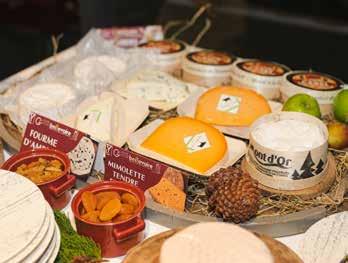
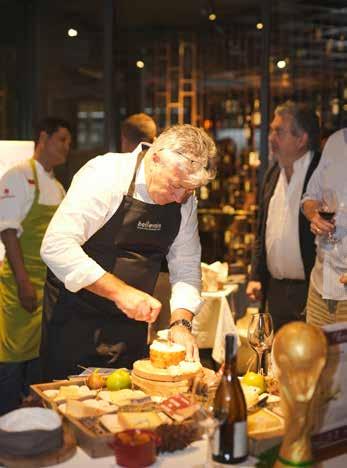
The atmosphere was lively and filled with excitement as attendees discussed the art of pairing. The discussion reached its peak with Baked Mont D’or, a special seasonal cheese only available in winter, which pairs well with Marrenon Pinot Noir Les Grains. The oozy cheese, served with crunchy baguette, captured all the connoisseur’s attention. The journey incorporated the taste development of the Bleu d’Auvergne cheese, and a Syrah from Marrenon Crozes Hermitage – Les Belles Echappees. As strong blues need bold partners, its robust flavour harmonised well with the vintage red.
The overall experience provided guests with much more than just a cheese and wine tasting. Instead, it was an opportunity to be inspired by the chefs’ creative use of wine and cheese in harmony. The journey came to an end with several chefs enthusing about the tasting menu and how to combine the cheese and wine on their own menus.
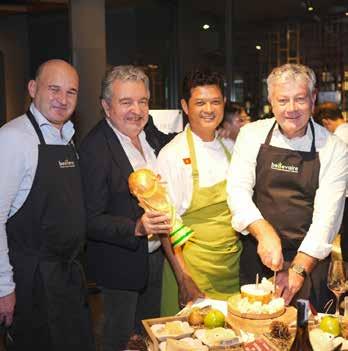
Television has a long and successful track record of food and cooking shows –from the first black and white forebears to the more technically advanced versions now enjoyed around the world
There’s something about watching talented chefs cooking great food that’s hugely appealing –whether you plan to replicate their recipes or go back to a completely different kind of TV dinner. But when did cooking on TV begin, and why is it so popular?
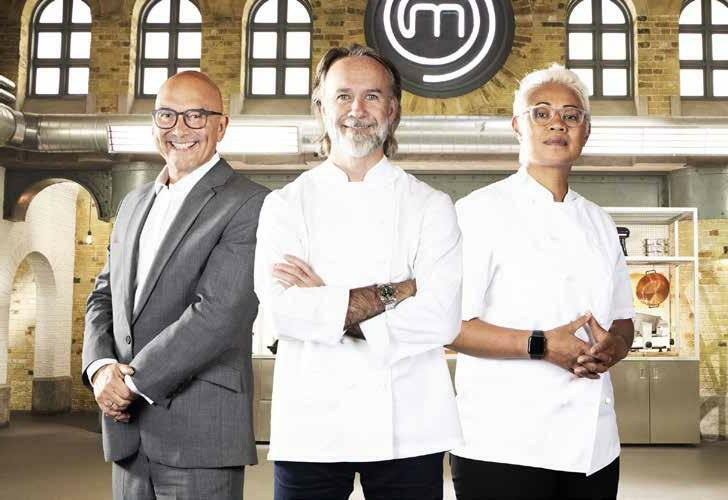
The first television cooking show, broadcast in the UK on June 12, 1946, was “Cookery”. Presented by already wellknown chef Philip Harben, wearing his famous striped apron, the show was in black and white and ran until 1951, each episode only 10 minutes long. Rationing in a postwar society was still in effect, and the chef sometimes used his own rations as ingredients.
The first American television show “Love to Eat” began airing only a few months after the British version, featuring cookbook author James Beard.
The next 70 years saw a variety of new shows. In 1955 Fanny Cradock captured the imagination of a nation with her “Kitchen Magic” in the UK, while Graham Kerr was a big hit in Canada with “Galloping Gourmet”. Delia Smith launched her stellar career in the UK in 1973, while 1986 saw the first Martha Stewart show, “Holiday Entertaining” in the US.
Other notables included “Madhur Jaffrey’s Indian Cookery” in 1982, 1994’s Gary Rhodes with “Rhodes About Britain”, Hugh Fearnley-Whittingstall’s “Cook on the Wild Side” in 1997, Nigella Lawson with “Nigella Bites” in 2000, 2002’s “A Cook’s Tour” featuring Anthony Bourdin, Gordon Ramsay’s “Hell’s Kitchen” in 2005 and many more.
One of the most popular TV formats is Master Chef, a competitive cooking reality show where contestants compete to win cash and other prizes, such as releasing their own cook books.
As modern technology progressed, so has TV cooking shows, but the format is as popular a form of entertainment for viewers now as it was back at the beginning.
年,Martha Stewart 在美國推出首 個飲食節目《Holiday Entertaining》。 其他著名的烹飪節目包括 1982 年的《Madhur Jaffrey’ s Indian Cookery》、1994 年 Gary Rhodes 的《Rhodes About Britain》、Hugh Fearnley-Whittingstall 於 1997 年主持的《Cook on the Wild Side》、2000 年 Nigella Lawson 的《Nigella Bites》、2002 年由 Anthony Bourdin 主持的《A Cook’ s Tour》,以及 2005 年 Gordon Ramsay 的《Hell’ s Kitchen》等。
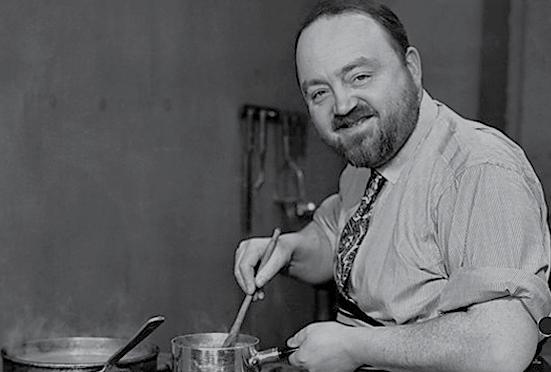
Having discovered early that his culinary route lay in western, rather than Asian cuisine, Chef Eric Neo of Capella threw himself into not only becoming the best professional possible, but also representing the industry and inspiring the next generation
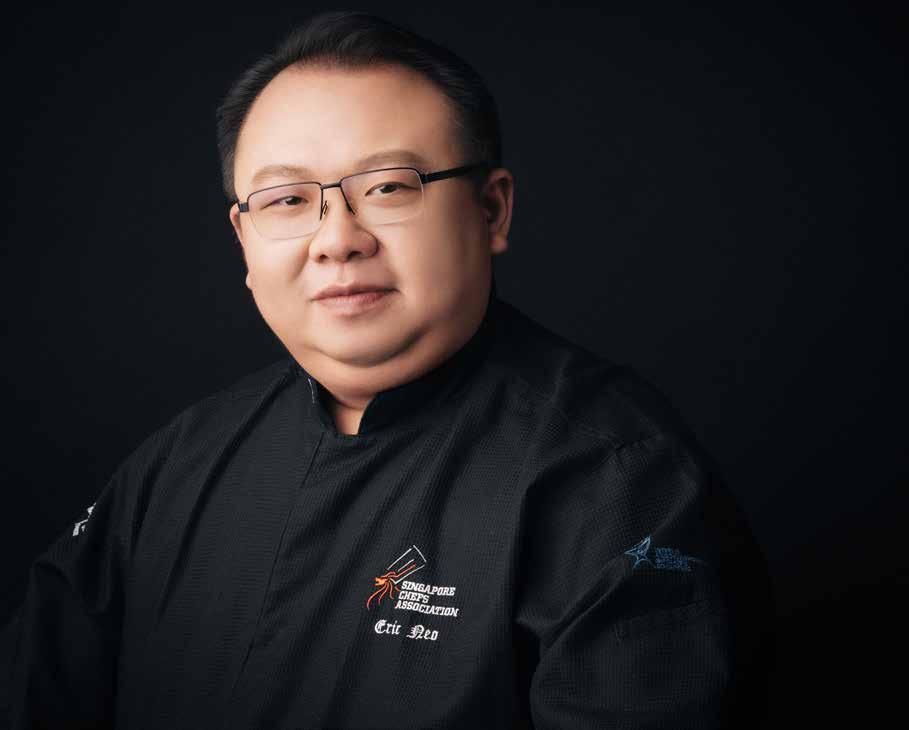
FT(Foodtalk): Unlike some chefs you were not drawn to the profession from an early age – what eventually made you realise this was the career for you?
And why did you decide to go the western rather than Chinese culinary route?
EN(Eric Neo): As a school dropout at the age of 16, I didn’t know what to do.
So with the encouragement of my parents, I enrolled as an apprentice with the
Restaurant Association of Singapore incorporating a work attachment with Dragon City Szechuan Restaurant. I did not like the work and after two weeks decided to leave, moving on to try out at a local western kitchen where I realised suited me better.
FT: You had extensive experience at Marina Mandarin Hotel Singapore (now Parkroyal Collection Marina Bay), Crowne Plaza Changi Airport, and most recently, InterContinental Singapore as executive chef. How do you feel this prepared you for your current position? You were also the first Asian to be appointed as executive chef at an international hotel chain in Singapore (Crowne Plaza), at the age of 30. Do you feel you were something of a pioneer?
EN: Experience prepares you for the next challenge, allowing you to see and manage things differently. This has helped to shape how I manage my current position. As for being a pioneer, I don’t really feel that way – there were others who were given executive chef positions even younger than me. It was a very good opportunity and I was lucky to be given the chance to prove myself.
Can you describe your main cooking inspiration and philosophy?
EN: My cooking inspiration comes from how Asian herbs and spices can be mixed to create unique sauces for particular dishes. This comes from my Asian roots and love for local and Asian cuisine generally. My philosophy is to use fresh, good quality produce to produce great dishes.
Did you find the transition from cooking to budgeting and cost control an easy one? Did it come naturally to you?
EN: It’s a must to eventually gain an understanding of this. As a cook, strictly speaking you only need to know how to cook correctly, accordingly to the chef’s instructions and strict recipes. However, in today’s world, the cook also needs to learn how to calculate costs and recommend selling prices. The earlier cooks learn this, the sooner they are ready for the next move.
How do you ensure everyone on your team is on the same page? And as Capella Singapore has Cantonese and Italian restaurants, each with its own executive chef, how closely do you work with them, or do they operate independently?
EN: As our team is large, we give outlet section leaders clear directions and expect these instructions to be passed down. We explain the rationale of actions or changes, and get their buy-ins. Those two outlets are managed by a chef de cuisine and executive Chinese chef, but I work closely with them to plan culinary offerings, discuss styles and trends and set targets, while
EN: 過往的經驗可協助你迎接未來的挑戰,並讓你能以不同的 方式了解和處理問題。這些經驗都塑造了我目前工作的處事方 式。我並不認為自己的成績是創先河之舉,業內還有一些比我 更年輕的廚師獲委任為行政總廚。無論如何,對我來說成為行
they work with their teams to execute these initiatives. We always plan ahead so there is time to effectively promote the outlets.
How important are issues such as sustainability and responsible sourcing at Capella?
EN: We are committed to be sustainable and source responsibly, and our procurement department works with suppliers that think the same way. This helps reduce our carbon footprint, save the oceans and contributes to making the world a better place.
You are president of the Singapore Chefs' Association and a certified judge for culinary at the World Association of Chef’s Societies, as well chairperson of the Asian Culinary Institute (ACI) Panel of Chefs. What is
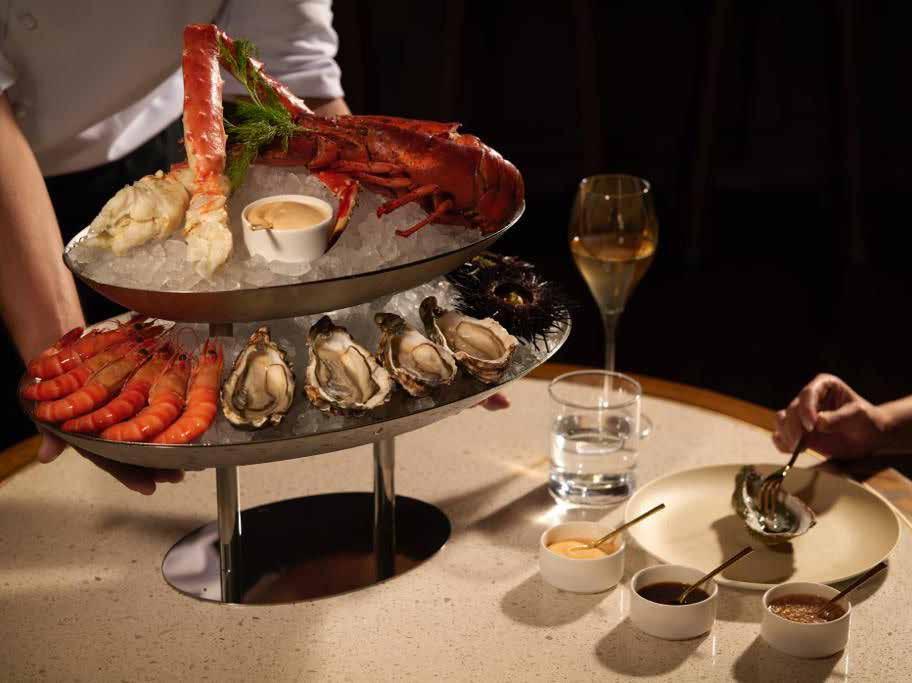
My philosophy is to use fresh, good quality produce to create great dishes
important to you about representing the industry in this way?
EN: I wear different hats and for every responsibility my input is different. For example, as a judge my international experience gives me an insight into ways dishes can be improvised and improved, whereby as chairperson of ACI I need to consistently manage and understand what the industry needs and ensure we meet these requirement. Most importantly, I represent the professional chef community.
You have also appeared on various television programmes as a guest judge and celebrity chef, including local shows such as Channel 8’s King Of Culinary. What do you enjoy about this involvement?
EN: In the past, chefs tended to stay in the kitchen. In the past 10 years, however, the media has started to feature a lot of food shows, which has given chefs a
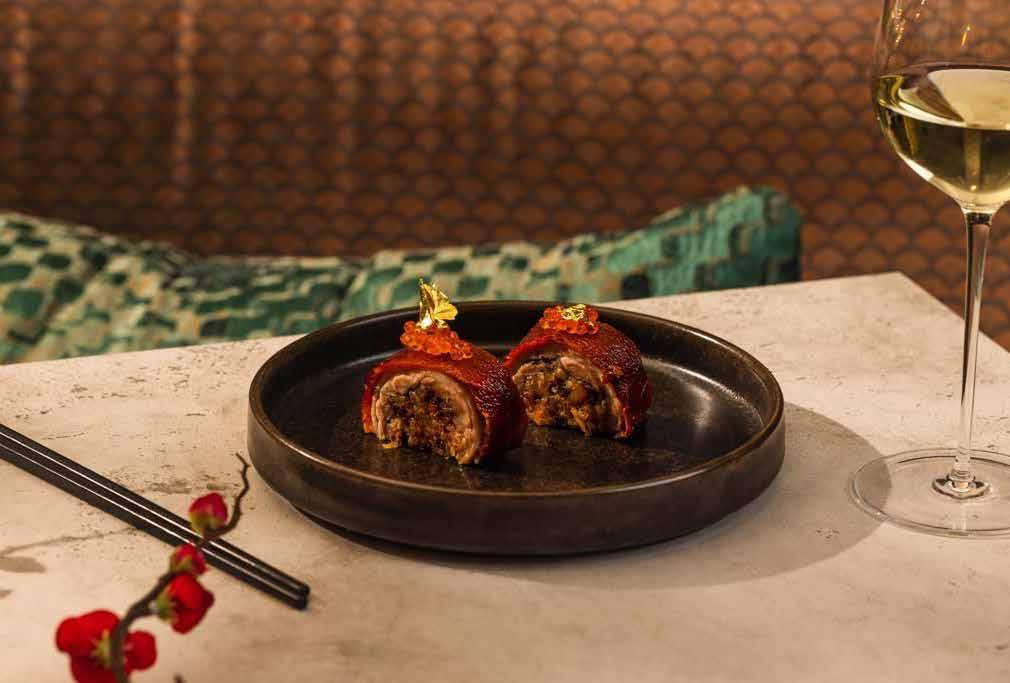
We are in a city that is evolving fast, and have to keep up with trends, aspiring to be trend setters in our own right as well
career lift and made people look at the profession with new respect. I enjoyed the real challenges provided during the shows, which also enabled me to hopefully inspire the younger generation of chefs to step up.
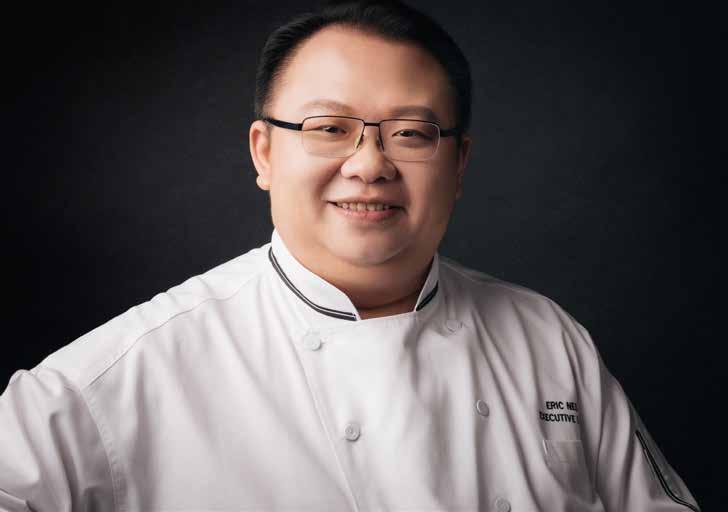
Singapore is a sophisticated foodie market. Do you feel you have your finger on the pulse of trends in the city? Do you try to anticipate what’s hot, or do you feel that keeping it simple and classic is enough of a draw in itself? And what’s your favourite dish?
EN: We are in a city that is evolving fast, and have to keep up with trends, aspiring to be trend setters in our own right as well. Some areas we keep classic – for example, heritage dishes which are a constant draw already. My favourite dish is Laksa, of which my favourite restaurant is a small, one-man place run by a guy named George.
以及成功的關鍵是什麼? BG: 由於這些都是享譽國際的獎項,而且評審標準相當嚴格, 因此對我來說獲得這些榮譽絕對是一大成就。這些獎項除了增 強了我的信心外,對我本人、與我一起共事的夥伴,以及一直 支持我的公司而言,亦是一份重要的認可。很高興多年來的學 習和培訓,終於得到回報。
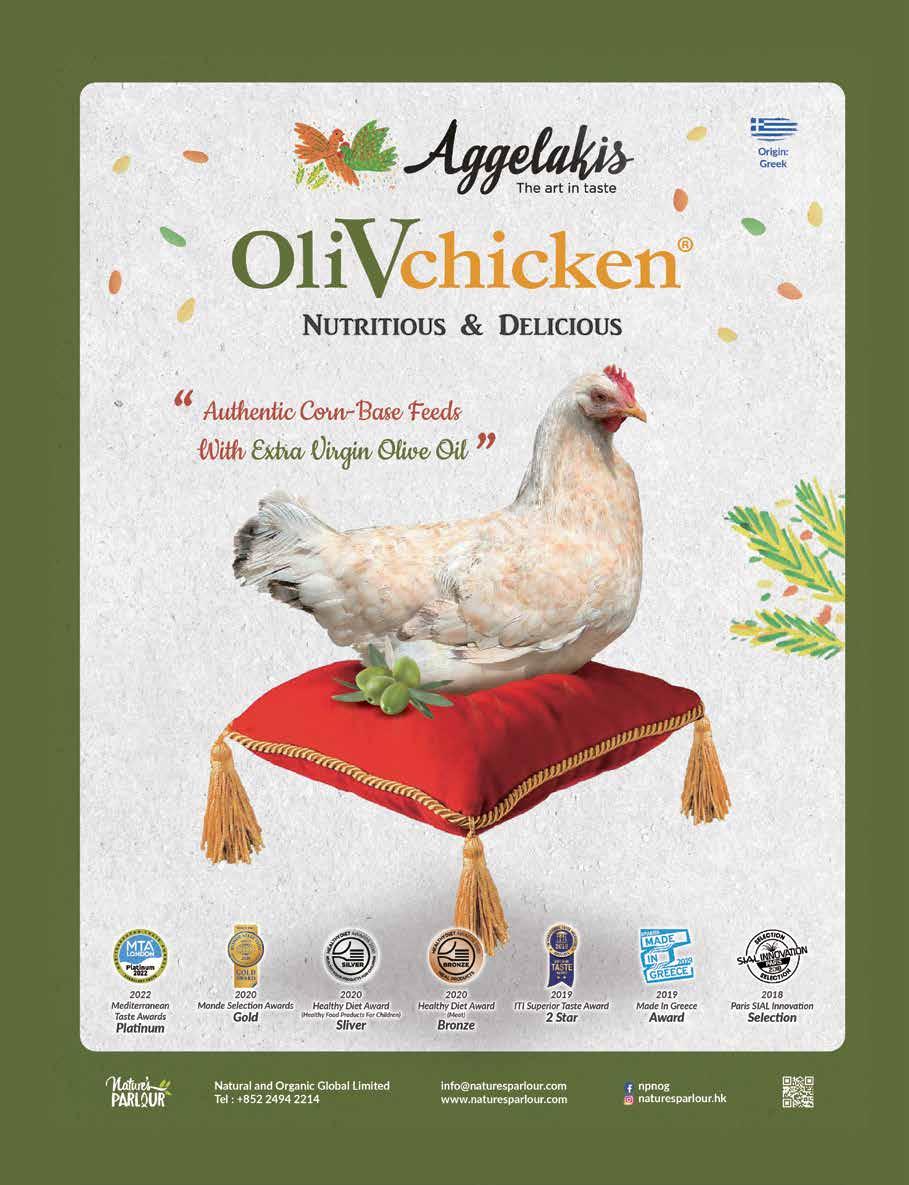
Just when we thought the patisserie world had nothing left to surprise and delight us with, along comes the kouign amann. Although it’s been around for 150 years, it is only now hitting a sweet spot of popularity
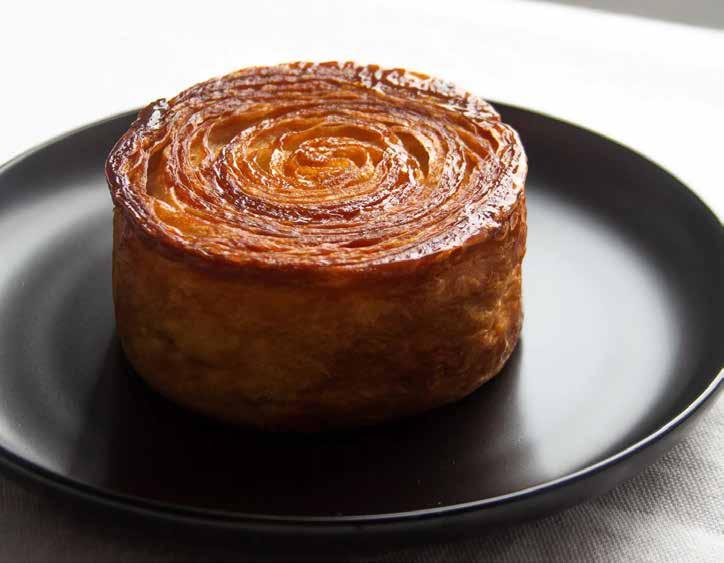
Never heard of – let alone tasted – a kouign amann? Join the club! Pronounced ‘kween ah-mon’, the buttery, flaky, caramel pastry isn’t very well known or widely available, even in France, but is definitely something you want to discover, although you may not know it yet!
While first thought to have been created in the town of Douarnenez in Finistère, Brittany, around 1860, the pastry has only recently caught on, not only in France but also around the world. This is a shame, as aficionados have described the artful mix of butter, sugar, and salt as a “near-perfect pastry experience.”
Its name, translating as “butter cake” in Breton, is a reasonable description of the principal ingredient, which, similar to a croissant, is combined with dough and then repeatedly folded and rolled. But this is where kouign amann parts ways with its more prosaic cousin. The addition of sugar between the layers means that as it bakes it caramelises, giving it a far richer and more delicious taste profile.
Like many pastry recipes, the formulation is very precise, with a ratio of 40% dough, 30% butter, and 30% sugar. It is typically baked as a large cake and served by the slice, although as its popularity has spread, individual cupcake or muffin-sized versions (kouignettes) have been selling like … well, hotcakes!
One place that has fully embraced the kouign amann is the United States. Here, bakeries in Salt Lake City and New York, including Dominique Ansel’s legendary Manhattan pastry shop (where the Cronut originated), cannot produce enough of the crispy, addictive bake. Isn’t it time you experienced the latest, classic pastry trend?
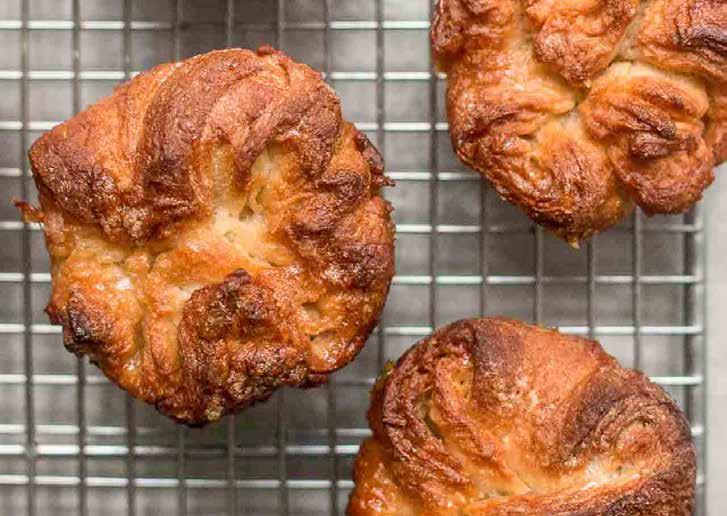
Chef Julien Xu incorporates his life experience into everything he cooks, drawing on his classic French and Michelin training and a unique interpretation of fusion to establish a connection with customers
(Foodtalk): Can you talk a little about your early years and how you decided to study classic French cuisine? JX (Julien Xu): This is the 20th year of my career. I cooked Mexican food in my early years. I still refer to this early experience – for example, the first dish of our seasonal set menu has Mexican elements. Later I worked in a hotel. After that, I was lucky to have the opportunity to study classic French cuisine with Michelin in Macau.
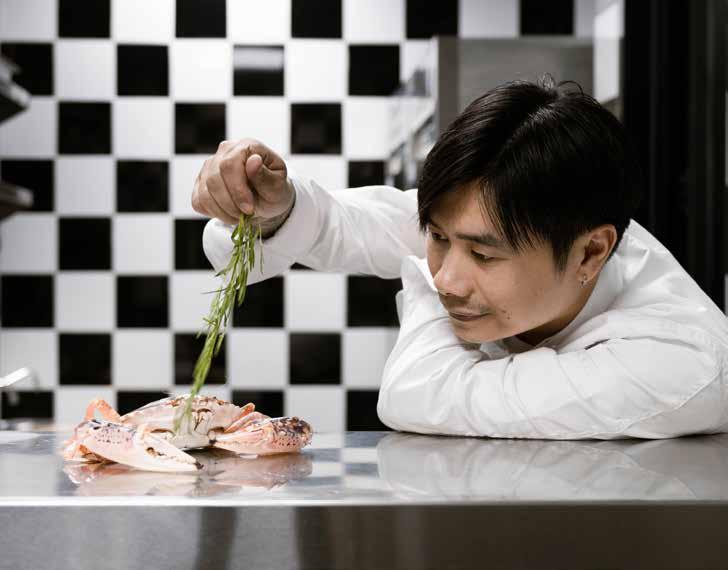
We incorporate the Chinese philosophy of eating according to seasonality and respect the characteristics of the ingredients. The balance of taste and flavour is what I want to achieve
FT: You worked at three-starred Michelin restaurants including Robuchon in Macau and Ultraviolet in Shanghai as sous chef, before moving to Puxuan Hotel in Beijing as executive sous chef, and opened Banyan Tree Hotel in Nanjing as executive chef. What did you learn from these great experiences?
優點。我的優勢在於擁有製作高級美食的經驗,以及在米芝蓮 餐廳工作了十年。此外,我亦曾經以行政總廚的身份,擔任兩 間五星級酒店開業籌備團隊的成員,這些都是相當難能可貴的 經驗。
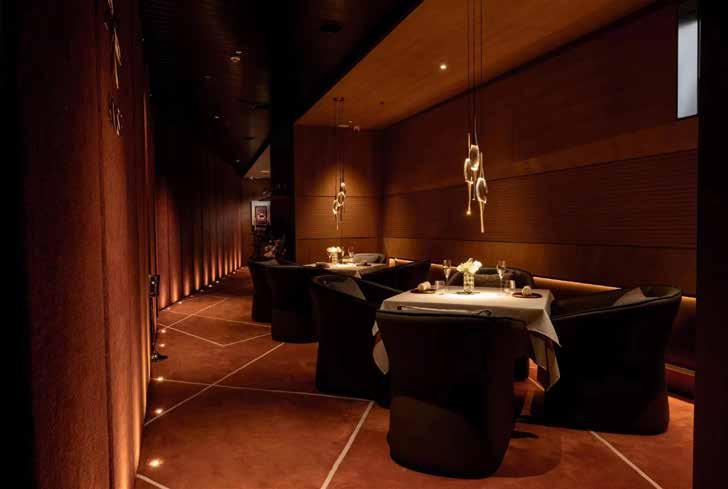
FT: ANISE offers a modern and innovative French culinary experience, but also fuses Cantonese and Shanghai cuisines and is inspired by local traditions and innovative dishes. Can you explain how this works in practice?
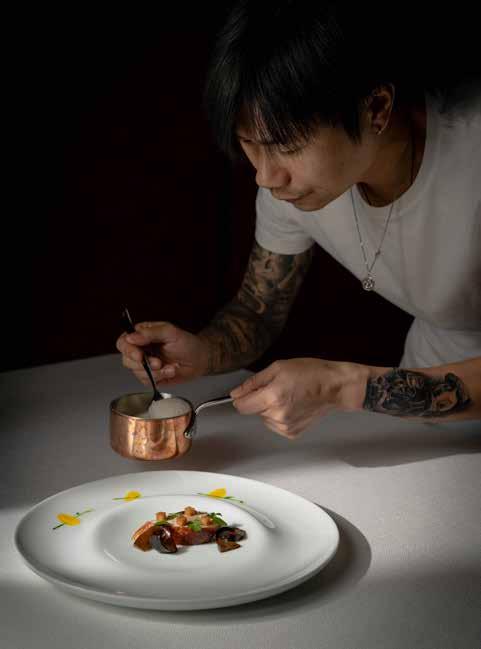
JX: Fusion dishes are very popular now in China. We call it fusion because the food culture is related to the local customs and people. Every place has its own seasonal ingredients and different eating habits, so adjustments must be made. As a Chinese, French cooking is a kind of fusion. Many people think that cooking by foreigners is more authentic. I think the most premium taste is of memory, which tends to resonate with people. My advantage is that I grew up with memories that foreign chefs didn’t have. Therefore, I can do fusion food better. Most of our clients are children of the 1970s, ‘80s and ‘90s. These three generations have shared memories.
FT: The restaurant is able to use local ingredients while maintaining its European identify, and incorporates the Chinese philosophy of eating according to seasonality. Is this easy to maintain?
JX: My version of fusion refers to the combining of culinary techniques, and the fusion of taste. For example, the integration of local Guangdong speciality, marinated raw seafood with geoduck, is a fusion of skills. But the fusion of flavour is rather complicated. We incorporate the Chinese philosophy of eating according to seasonality and respect the characteristics of the ingredients. The balance of taste and flavour is what I want to achieve.
FT: You have a reputation of using your own life experiences in menu creation and establishing strong connections with your customers. How do you achieve this?
JX: That’s super basic for me. With social development and progress, people now look beyond simply
eating luxury food with expensive ingredients. They want nutrition and health alongside a unique experience, which requires us to constantly come up with new ideas, or personally explain the inspiration and story behind each dish. The most premium taste is a memorable one, which is also the source of inspiration for my menu creation. It is impossible to make every dish memorable to customers, but if one or two can resonate with them, that’s success.
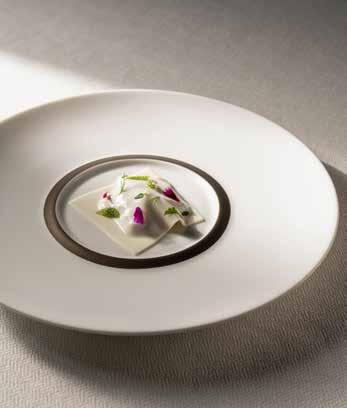
FT: Can you tell us anything about your signature dishes ‘Chris' Secret’, inspired by a ‘blind box’ game played by your daughter, and ‘Coffee & Toffee’, that recalls your childhood memories?

JX: You can conceive new dishes with fantasy and wishful thinking, but then have to decide whether you have the skills and ability to actually create them! For example, ‘Chris’ Secret’ was inspired by a blind box game with my daughter. Scallops look like a natural blind box – you can’t predict what’s inside before you open them. I'm also obsessed with coffee, its bitterness and astringency, and toffee is the taste of my childhood, so balancing them seemed natural. Double-layered milk custard took inspiration from a Cantonese dessert, with the milk skin smoked with apple wood and flavoured with clove and lemon to harness the crunchiness, giving the dish a balanced flavour with fragrance. It’s also perfect to complete a French meal.
你的招牌菜式名為「Chris' Secret」,創作靈感是來自你 女兒喜歡的「盲盒」遊戲,以及讓你勾起兒時回憶的「咖啡與 太妃糖」,你可否介紹一下這款菜式? JX: 雖然你可以透過幻想和心目中的理想來構思出新的菜式, 但菜式最終是否美味,還是取決於你的烹調技巧和能力! 舉例來說,「Chris' Secret」的靈感來自我女兒喜歡的盲盒 遊戲,菜式中的扇貝就好像一個天然的盲盒,在打開前你無法 預知裡面的東西。另外,我亦鍾情於咖啡和當中的苦澀味; 而太妃糖則是我兒時喜歡的味道,因此便不期然將兩者融合在
JX: Anise is a spice commonly used in Chinese and Western cuisine. Its shape is quite similar to the Eight Trigram [symbols used in Taoist cosmology]. The Chinese principle of Yin and Yang is that all things exist as inseparable and contradictory opposites. That means fusion dishes in ANISE are all-encompassing. Based on French cuisine, carefully selected seasonal high-end ingredients are integrated with different cuisines to bring clients a truly unique dining experience. The predominant colour of the restaurant is orange, red and brown. From the lounge area to the private room space, it also represents the deepening of the experience level.

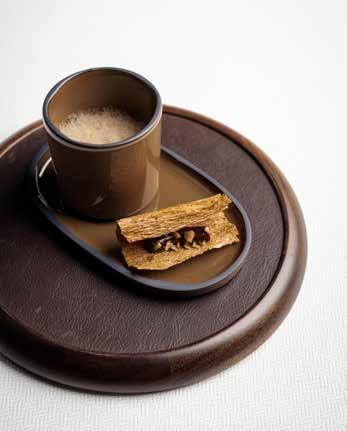
I put all my passion, my experience and life into my cuisine. That’s what gives me the greatest feeling of accomplishment
FT: Can you explain how ANISE got its name, and its design concept?
FT: French cuisine seems to be at an all-time high in terms of popularity in China. Do you know why this is?
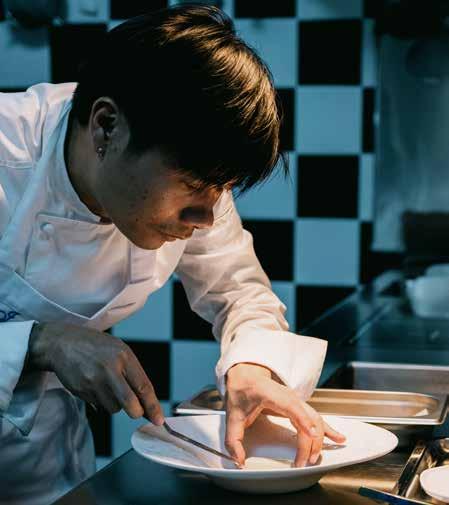
JX: French cuisine gives people a stronger sense of occasion. In addition, with the improvement of living standards, we can pursue finer and more elaborate culinary experiences. The number of Chinese studying and travelling overseas continues to increase, so it’s easy to have an immersive cultural experience. It’s not hard to understand why people want a better culinary experience.
FT: What drives you most and what do you always look to achieve?
Do you find you need to be constantly coming up with new ideas, or does the restaurant concept keep customers coming?
JX: If you have passion and love for what you do, you will be willing to put more effort in. As an executive chef I've already prepared and opened two hotels, but hotels are not really where I cook. I put all my passion, my experience and life into my cuisine. That’s what gives me the greatest feeling of accomplishment. Of course, restaurants need new ideas and concepts. To ensure freshness and incorporate better with the Chinese philosophy of eating according to seasonality, ANISE creates a new menu every three months.
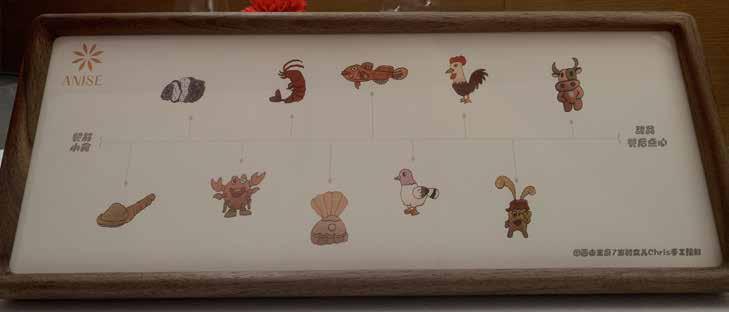
‘The High Jewellery of Butter’ event highlighted the extraordinary qualities of Échiré butter to a highly appreciate industry audience
Guangzhou and Échiré recently co-hosted a two-day event, entitled ‘The High Jewellery of Butter’. Angliss was proud to present premium Échiré butter and demonstrate how it can inspire a rich variety of pastry combinations. Angliss Guangzhou General Manager K.K. Tse kickstarted the event by expressing his gratitude to attending guests before highlighting Échiré’s outstanding versatility with other ingredients, thanks to its smooth texture and elegant flavour. Angliss Technical Team’s
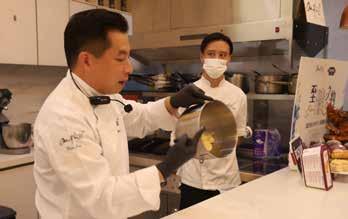
用方法及靈感。
感謝,十分榮幸能為大家帶來這款法國高級牛油。Échiré 牛油 優秀的延展性和淡雅風味讓其在操作和應用上表現出眾,安得 利大中華區烘焙技術顧問-呂冠漳師傅特別為大家展示了開酥和 牛油霜使用的過程和重點,客戶們都表示收穫良多。 本次的品鑒會環節十分多樣化,為了讓大家品嘗到更好的牛油

Chef Tom Lu brought out the butter’s unique subtlety during the process of making puff pastry and buttercream.
The wide range of activities held during the event included offering pure butter and buttercream for everyone to try, allowing its special flavour to be better appreciated. As Échiré butter starts to melt with the temperature in the mouth, it offers a smooth and soft texture with a fresh hint, followed by a milky and creamy aroma.
Various classic pastries were prepared and demonstrated at the event: croissants, brownies, millefeuilles, palmiers, kouign-amann, financiers and madeleines, to name a few. The flavour of Échiré butter was pronounced in each pastry.
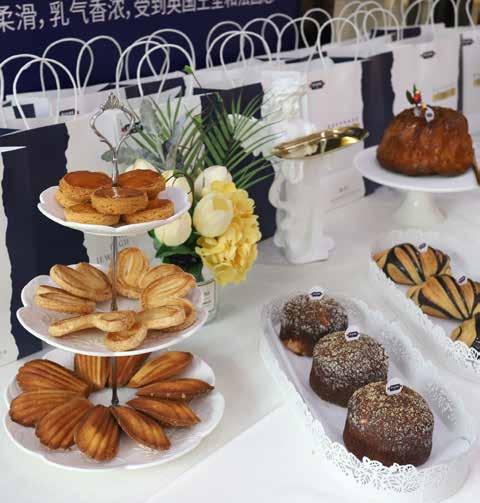
The Échiré butter tasting event was successfully concluded with all guests expressing their delight and satisfaction. Similar events are planned to take place in the future.

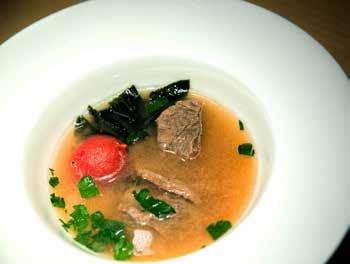
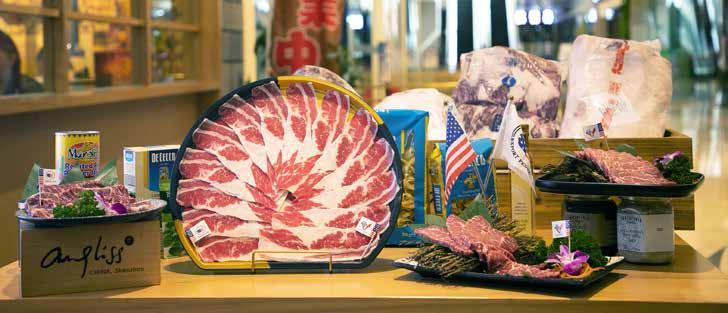
Angliss Shenzhen’s recent American Beef Tasting Party saw amazing beef cutting skills, alongside a variety of outstanding dishes which delighted industry attendees
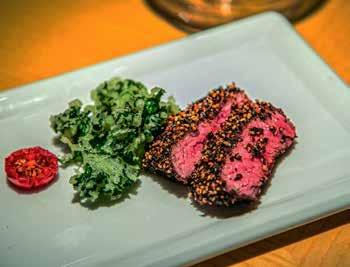
Around 40 customers were invited to attend a recent Beef Tasting Party organised by Angliss Shenzhen at Shihao Steak House in Zhuoyue INTOWN Shopping Mall and LiShao Kaorouguan in Kingkey Banner Centre. At the exciting event, clients were able to understand, taste, and explore more about American beef with other guests.
At the tasting party, Angliss Shenzhen was honoured to have Chef Shen Zhilong, the General Manager (Meat Business Development) of Angliss Greater China, to demonstrate his brilliant skills in beef cutting, and share his knowledge and expertise. All the meat for the Beef
Tasting Party was provided by Angliss, with sumptuous dishes including barbecued meat and a variety of western dishes, beef patties with ham and truffle mushrooms, grilled steak with sweet pepper sauce, Thai beef salad, black pepper steak with kale, beef tendon miso soup, and more.
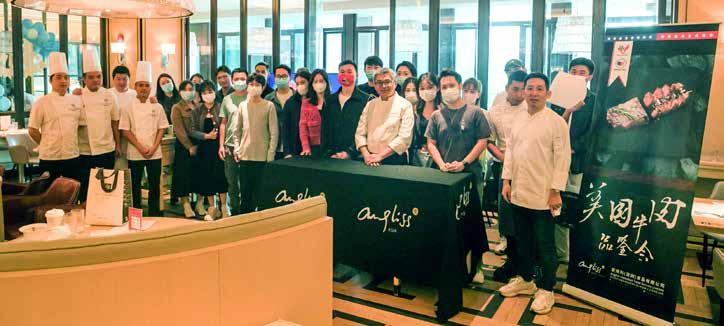
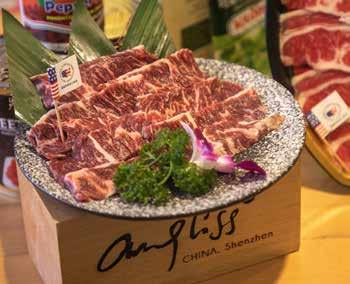
Mr. Shen's fascinating demonstration, together with the high-quality ingredients, won unanimous praise from customers. In the future, Angliss Shenzhen will continue to provide customers with professional technical support and share innovative dishes. Angliss Shenzhen will also continue to present more exciting food and catering solutions to its customers and the public.
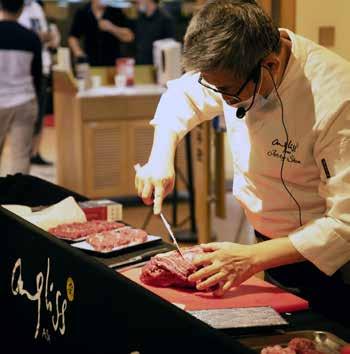
In a boost for the Horeca sector, hotels in Hong Kong have improved their performance due to the influx of tourists following greater control of the pandemic, according to a report from Knight Frank, a leading local real estate consultancy. Overnight visitor arrivals reached over 175,000 for the first eight months of 2022, increasing by 234% year-on-year. www.content.knightfrank.
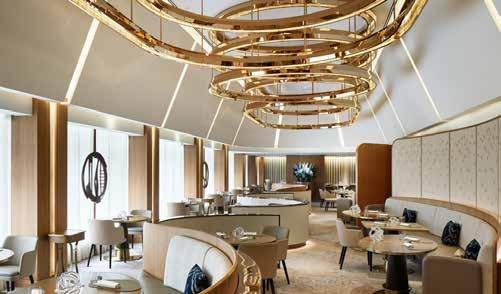

Popular lifestyle news website The Loop HK has announced its annual ‘30 Best Eats 2022 winners’ list’. The list features French fine dining perennial Amber, headed by chef Richard Ekkebus; A Lux by Dining Art Group, an intimate restaurant specialising in Italian-French cuisine; Chinesology, which offers a contemporary Tang Dynasty-themed menu; and Embla, a Nordic seasonal fine dining restaurant.
https://theloophk com/30-besteats-2022-winners/

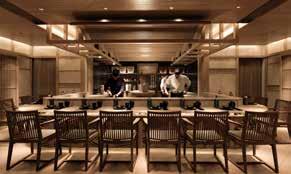

The bustling neighbourhood of Sheung Wan has welcomed a casual fine dining destination, Rêveri, offering contemporary pan-Asian cuisine. Helmed by experienced F&B and hospitality trailblazers Jessica Kesumo and John Law, Rêveri offers a warm and intimate dining experience showcasing simple and high-quality dishes. The tasting menu presents a complex fusion of Asian flavours and western cooking styles.
https://www.reverihk.com
management company Dining Art Group has launched an eclectic dual-concept venue featuring two distinctive Japanese dining experiences – traditional kappou cuisine and a contemporary gastrobar under one stylish roof. Kappou Mu and room 3, in Tsim Sha Tsui, extend over a 3,000-square-foot venue, combining omakase kappou with cocktails and Japanese tapas at vibrant room 3, a modern-day speakeasy. https://dagroup.hk
Japanese master chef Terufumi Mihara has opened Trattoria Kagawa by Mihara at J Senses on bustling Ship Street, Wan Chai. Offering an array of refined Italian-Japanese delicacies, his latest Hong Kong venture introduces the cuisine and fresh produce of Kagawa, his home prefecture. The showpiece 10-seat teppanyaki bar counter is enhanced by a 1,000-square-foot dining area seating 42 people. www.facebook.com/trattoria.kagawa/
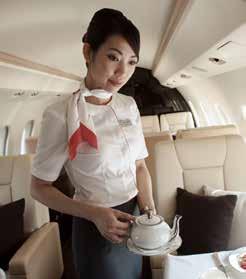
aircraft has reformulated its in-flight menus and created exclusive meals prepared for fine dining at 45,000 feet. Each dish uses fresh ingredients with a balance of flavours. The menu also takes air turbulence into account. VistaJet’s partner restaurants include Michelin-starred Tosca di Angelo at The Ritz Carlton, Hong Kong; and Origin Grill, at the Shangri-La Singapore. www.vistajet.com


Johor Bahru launched its largest festive campaign yet since opening in 2017, offering Christmas activities, events and deals to both its local guests and holidaymakers and raising money for charity in the process. The hotel also organised a Gingerbread Cookie Deco Workshop for over 100 children and their families. Participation was through donations to the Tunku Laksamana Johor Cancer Foundation. www.amari.com/johor-bahru

Coca-Cola Singapore and McDonald’s Singapore hosted a Football Fiesta Robot Keeper at the Coke Football Fiesta Tour over the festive period, at Resorts World Sentosa. Participants had the chance to score a goal against the robo-keeper, or could also try the Header Challenge, jumping as high as Cristiano Ronaldo’s famous leap of 2.56 metres to head a goal against Sampdoria. www.cokefiestatour.com

Singapore 新加坡
南寧
Angliss Singapore Pte Ltd 232 Pandan Loop, Singapore 128420 T. +65 6778 8787 | F. +65 6778 3966
Angliss Macau Food Service Limited 196-242 Rua dos Pescadores, Edf Industrial Ocean II Fase, 4-Andar C & D, Macau 安得利澳門飲食服務有限公司
澳門漁翁街196-242號海洋工業中心2期4樓C&D室 T. +853 2886 2886 | F. +853 2886 2828
Angliss Beijing Food Service Limited No. 10 Hongda South Road, Yi Zhuang Economic & Technological Development Zone, Daxing District, Beijing, China 安得利(北京)食品貿易有限公司
北京市大興區亦莊經濟技術開發區宏達南路10號
T. +86 10 8908 3501 | F: +86 10 8586 4880
Angliss Beijing Food Service Limited - Tianjin Branch Rm 320, Yunhan Building, 185 Qinjian Road, Hongqiao District, Tianjin 安得利(北京)食品貿易有限公司天津分公司
天津市紅橋區勤儉道185號雲漢大廈320室 T. +86 22 8729 0198
Shenyang 瀋陽
Angliss Shenyang Food Service Limited 1-11-12, 10-2 Hunnan West Road, Hunnan New District, Shenyang 安得利(瀋陽)食品貿易有限公司
瀋陽市渾南新區渾南西路10-2號1-11-12 T. +86 24 8122 1688 | F. +86 22 8122 1688
Shijiazhuang 石家莊
Angliss Shijiazhuang Food Service Limited Rm 1107, Block E, Haiyuetiandi, 66 Yuhua West Road, Qiaoxi District, Shijiazhuang City, Hebei Province 安得利石家莊食品貿易有限公司
河北省石家莊市橋西區裕華西路66號海悅天地E座1107室 T. +86 311 8262 1608
Angliss Shandong Food Service Ltd Rm 1418, Quanjing Yayuan Commercial Building, Shizhong District, Jinan City, Shandong Province 山東安得利食品貿易有限公司
山東省濟南市市中區泉景雅園商務大廈1418室 T. +86 531 8711 9769
Angliss Shanxi Food Service Ltd
Rm 925, 9F, Feiyun Apartment, 186 Pingyang Road, Xiaodian District, Taiyuan City, Shanxi Province 山西安得利食品有限公司
Angliss Hefei Food Service Ltd 4F, Block 54, Phase 1, Liandong U Valley Binhu International Enterprise Port, Fanhua Avenue Intersection Of Jilin Road, Baohe District, Hefei City 合肥必利食品有限公司 合肥市包河區繁華大道與吉林路交口聯東U穀濱湖國際
Guangzhou 廣州
Angliss Guangzhou Food Service Limited 21F, No. 83 & 85 Baiyun Road, Yuexiu District, Guangzhou 廣州安得利福斯食品有限公司
廣州市越秀區白雲路83及85號21層
T. +86 20 8921 9188 | F. +86 20 8921 9168
Angliss Chengdu Food Service Limited No. 870 Gangtong North Fourth Road, Chengdu Modern Industrial Port North Area, Pidu District, Chengdu 成都安得利福斯食品有限公司
成都市郫都區成都現代工業港北片區港通北四路870號
T. +86 28 6482 6608 / +86 28 6496 6001
Chongqing 重慶
Angliss Chengdu Food Service LimitedChongqing Branch
Rm 6, 3F, 95 Erlang Chuangye Avenue, Jiulongpo District, Chongqing 成都安得利福斯食品有限公司-重慶辦事處 重慶市九龍坡區二郎創業大道95號3樓6號 T. +86 23 6330 2009
Kunming 昆明
Angliss Kunming Food Service Limited (Zhengming Cold Storage), Liangting East Road, Guandu District, Kunming 昆明安得利福斯食品有限公司
昆明市官渡區涼亭東路雲南(鄭明冷庫)
T. +86 871 6319 4072
Bidfood Nanjing Ltd Shop 32, 2F, Second Hall, 249 Changhong Road, Jianye District, Nanjing City, Jiangsu Province 南京安必福食品有限公司 江蘇省南京市建鄴區長虹路249號二廳二樓32號商鋪 T. +86 25 8675 9306 | F. +86 25 8622 8102 Shanxi 山西
Angliss Xiamen Food Service Limited Room 1503, No. 506, Xinglinwan Road Jimei District, Xiamen, China 廈門安得利福斯食品有限公司 廈門集美區杏林灣路506號1503室 T. +86 592 5635 636
Fuzhou 福州
Angliss Xiamen Food Service Limited - Fuzhou Office
Rm 302-303, 3F, Taikun Center, 166 Guanpu Road, Cangshan District, Fuzhou City 廈門安得利福斯食品有限公司 - 福州辦事處
福州市倉山區冠浦路166號泰坤中心3樓302-303室 T. +86 591 83650383
Foshan 佛山
Shanghai 上海
Angliss Shanghai Food Service Limited
Rm 5B, Block 4, 100 Zixiu Road, Minhang District, Shanghai 上海安得列郎晴食品貿易有限公司 上海市閔行區紫秀路100號4號樓5B
Hangzhou 杭州
Angliss Hangzhou Food Service Limited
Rm 4001, 4F, Block 1, 1298 Danonggang Road, Jianggan District, Hangzhou 杭州安鍀利食品有限公司
Angliss Foshan Food Service Limited No. 12 Jiangsha 2nd Road, Chancheng District, Foshan City 佛山安得利食品有限公司
Angliss Shenzhen Food Service Limited No. 1, Mabu Road, Bainikeng Community, Pinghu Street, Longgang District, Shenzhen, Guangdong Province 安得利(深圳)食品有限公司
廣東省深圳市龍崗區平湖街道白坭坑社區麻布路一號 T. +86 755 2885 7688 | F. +86 755 2518 5406
Angliss Nanning Food Service Limited Rm 107, Block 22, Guangxi-Asean International Medical And Health Electronic Information Technology Comprehensive Industrial Park, 9 Dingqiu Road, Jiangnan District, Nanning City 南寧安得利食品有限公司
南寧市江南區定秋路9號廣西-東盟國際醫療健康電子資訊科技 綜合產業園22棟107號房 T. +86 771 3947 620 F:+86 771 3947 646
Angliss Xi'an Food Service Limited No.333, 10 Caotan Road, Caotan Ecological Industrial Park, Xi'an Economic & Technological Development Zone, Xi’an City, China 安得利(西安)食品有限公司
西安市經濟技術開發區草灘生態產業園草灘十路333號 T. +86 29 8873 4883 | F. +86 29 8873 4883
Angliss Zhengzhou Food Service Limited Changtong Industrial Park, Xiapo Yang Village, Laoyachen Office, East Section Of Jiangshan Road, Huiji District, Zhengzhou City 鄭州安得利食品有限公司
鄭州市惠濟區江山路東段老鴉陳辦事處下坡楊村長通工業園
T.+86 371 8991 0680 | F.+86 371 8991 0681
Hunan 湖南
Angliss Hunan Food Service Limited 3F, Block 1, Xinxing Technology Industrial Park, Muyuntuo Street, Tianxin District, Changsha City Tianxin District, Changsha, Hunan, China 湖南安得利食品有限公司 長沙市天心區暮雲南托街道新興科技產業園1棟3樓 T. +86 731 8556 9552 | F. +86 731 8556 9553
Nanchang
Hunan Angliss Food Service Limited - Nanchang Branch NEW Building 15, Weimafengshang community, Guangzhou road, Qingyunpu district, Nanchang City, Jiangxi Province 湖南安得利食品有限公司(南昌分部)
Wuhan 武漢
Angliss Wuhan Food Service Limited Rm 1, 1-3F, Building D4, Phase 1 Huazhong Enterprise City, Douma River, Qinglong Branch, Wuhu Farm, Huangpi District, Wuhan 武漢安得利食品有限公司
1-3層1室 T. +86 27 6180 0941 | F. +86 27 6180 0942
Haikou 海口
Angliss Haikou Food Service Limited No. 22 Xingye West Road, Hong Kong And Macao Development Zone, Xiuying District, Haikou City, Hainan Province 海口安得利食品有限公司
三亞
Angliss Sanya Food Service Limited 1-3F, Comprehensive Building A, Yuge Haiyun, Hongsha Community, Jiyang District, Sanya City, Hainan Province 三亞安得利食品有限公司
海南省三亞市吉陽區紅沙社區漁歌海韻A棟綜合樓 (一至三層商業) T. +86 898 8863 0068 F. +86 898 8863 0318 / +86 898 6595 4474
Zhuhai 珠海
Angliss Shenzhen Food Service LimitedZhuhai Warehouse 1F, Block 3, No. 2 Pinggong West Road, Xiangzhou District, Zhuhai City, Guangdong Province 安得利(深圳)食品有限公司-珠海辦事處
PastryGlobal Food Service Limited
Flat B, 6/F, Magnet Place Tower 2, 38-42 Kwai Fung Crescent, Kwai Chung, N.T., Hong Kong 嘉寶食品有限公司
香港新界葵涌葵豐街38-42號Magnet Place 2期6樓B室
T. +852 2494 1900 | F. +852 3145 0756 www.pastryglobal.com.hk
Miumi International Food Company Limited Flat A, 4/F, Magnet Place Tower 2, 38-42 Kwai Fung Crescent, Kwai Chung, N.T., Hong Kong 御海國際食品有限公司
香港新界葵涌葵豐街38-42號Magnet Place 2期4樓A室 T. +852 2494 4966 | F. +852 2439 4070 www.miumi.asia
Gourmet Cuisine Hong Kong Limited Flat A, 6/F, Magnet Place Tower 2, 38-42 Kwai Fung Crescent, Kwai Chung, N.T., Hong Kong
高美食材香港有限公司
香港新界葵涌葵豐街38-42號Magnet Place 2期6樓A室 T. +852 2494 1967 | F. +852 2439 5055
foodtalk 名廚坊
Shop 10, G/F Tower 1 Magnet Place, 77-81 Container Port Road, Kwai Chung, New Territories 香港新界葵涌貨櫃碼頭路77-81號
Magnet Place一期地下10號舖 T. +852 2615 0822 | F. +852 2615 0855
Hong Kong Island shop: G/F, 23 First Street, Sai Ying Pun, Hong Kong 香港西營盤第一街23號地下 T. +852 2615 0338 | F. +852 2559 3938
Kowloon shop: G/F, 21 Nanking Street, Jordan, Kowloon, Hong Kong 香港九龍佐敦南京街21號地下 T. +852 2615 9187 | F. +852 2615 9287 www.foodtalk.com.hk
Linson Global Seafood Trading Limited 隆順環球海產貿易有限公司 47-51 Kwai Fung Crescent, Kwai
Lou Lou Food Market 47-51 Kawi Fung Crescent, Kwai Chung, N.T., Hong Kong 香港新界葵涌葵豐街47-51號 E: info@louloufm.com www.louloufm.com

Miumi Tokyo Co., Ltd. 御海東京株式會社 Room 501, 2-6-3, Azabujuban, Minato-ku, Tokyo 106-0045 Japan T. +81 3 6721 5689 | F. +81 3 6721 5693
Sweet la Vie 47-51 Kwai Fung Crescent, Kwai Chung, N.T., Hong Kong 香港新界葵涌葵豐街47-51號 T. +852 2494 1935 | F. +852 2615 2210 www.sweetlavie.com.hk
Miumi Japan Food (A Division of Angliss Singapore Pte Ltd) 232 Pandan Loop, Singapore 128420 御海日本食品有限公司 T. +65 6777 2112 | F. +65 6779 7666
Gourmet Partner (S) Pte Ltd 232 Pandan Loop, Singapore 128420 T. +65 6602 0790 | F. +65 6778 0153
Gourmet Partner (M) Sdn Bhd No. 12, Jalan Anggerik Mokara 31/48, Kota Kemuning, 40460 Shah Alam, Selangor, Malaysia T. +603 5122 6601 | F. +603 5121 0601
Him Kee Food Distribution Company Limited Flat B, 4/F,
FoodPride
1 Second Chin Bee Road, Singapore 618768 T. +65 6275 9275 | F. +65 6863 3855
Natural and Organic Global Limited
Flat B, 4/F, Magnet Place Tower 2, 38-42 Kwai Fung Crescent, Kwai Chung, N.T., Hong Kong 安機源優質食材有限公司
香港新界葵涌葵豐街38-42號Magnet Place 2期4樓B室 T. +852 2494 2214 | F. +852 2702 1290
Bidfood Malaysia Sdn Bhd No. 12, Jalan Anggerik Mokara 31/48, Seksyen 31, Kota Kemuning, 40460 Shah Alam, Selangor, Malaysia T. +603 5131 6399 | F: +603 5131 9233 www.bidfood.com.my
